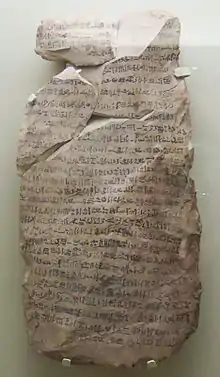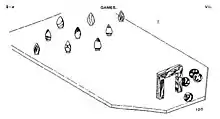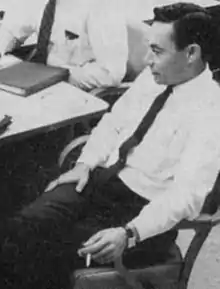List of Egyptian inventions and discoveries
Egyptian inventions and discoveries are objects, processes or techniques which owe their existence or first known written account either partially or entirely to an Egyptian person.
Prehistoric Egypt
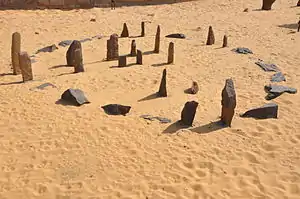
- Underground mining – Khater-4 site which is 33,000 years old is the oldest evidence of underground mining in the history of the world.[1]
- Preserving food by smoking existed during the Mesolithic period (20,000 BC.) in Egypt.[1]
- Swimming – The oldest known swimming scenes are found in the Cave of swimmers.
- Warfare – The earliest evidence of violence and tribal wars is Site 117.[2] Since the rise of the state some 5,000 years ago,[3] warfare between Predynastic city states and the wars of the unification of Egypt started as early as 3800 BC.
- Early planting appeared in Egypt as early as Qadan culture (13,000 B.C. – 10,000 B.C.).[4]
- Sickles – Around 11,000 B.C. The people of the Qadan Culture in Upper Egypt and Lower Nubia invented the world's oldest sickle blades.[5]
- Digging wells – The earliest known wells were dug in Nabta Playa around 7000 BC.[6]
- Astronomy – The astronomical alignments found in Nabta Playa are considered the world's oldest Astronomical devices.[7]
- Lunar calendar – The stone circle at Nabta Playa dating to 5,000 BC. is considered the oldest known lunar calendar.[8]
Ancient Egypt
Government and Economy
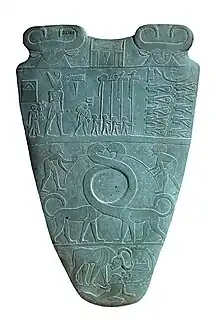
- Taxation – Taxation in Egypt started during the reign of king Iry-Hor and perhaps as early as Scorpion I.[9]
- Peace treaty – The Earliest recorded peace treaty in the history of the world that survived to modern days was signed between the pharaoh Ramesses II and the Hittite king Muwatalli II after the Battle of Kadesh (1274B.C.).[10]
- Women's rights – In ancient Egypt, women enjoyed the same rights under the law as a man, however rightful entitlements depended upon social class. Landed property descended in the female line from mother to daughter, and women were entitled to administer their own property. Women in ancient Egypt could buy, sell, be a partner in legal contracts, be executor in wills and witness to legal documents, bring court action, and adopt children.[11]
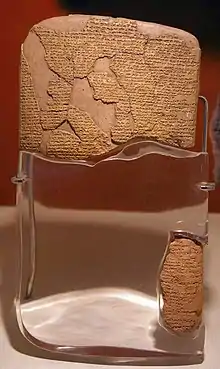
- Law – Ancient Egyptian law, dating as far back as 3000 BC, was based on the concept of Ma'at and characterised by tradition, rhetorical speech, social equality and impartiality.[12][13][14]
- Flag or Emblem – As early as the Predynastic times, each nome had its own standard.[15]
- Strike action – The first historically certain account of strike action was towards the end of the 20th Dynasty, under Pharaoh Ramses III in ancient Egypt on 14 November in 1152 BC. The artisans of the Royal Necropolis at Deir el-Medina walked off their jobs because they had not been paid.[16][17]
- Civil war – The first recorded civil war in the history of the world occurred at the end of the First dynasty when its last king, Qa'a died and a dynastic war began between his successors: Sneferka, Horus Bird and Hotepsekhemwy.[18][19][20]
- Religious war and Rebellion – Khasekhemwy managed to reunite Upper and Lower Egypt after a civil war between the followers of the gods Horus and Set.[21]
- Community banking models – Community banking is a non-traditional form of money-lending.[22] Unlike banks or other classic lending institutions, the funds that community banks lend to borrowers are gathered by the local community itself. This tends to mean that the individuals in a neighborhood or group have more control over who is receiving the capital and how that capital is being spent. This practice has existed in some form for centuries; in ancient Egypt, for example, when grain was often used as currency, local granaries would store and distribute the community's food supply.[23] Since that time, a variety of community banking models have evolved.
- Police – In ancient Egypt evidence of law enforcement exists as far back as the Old Kingdom period. There are records of an office known as "Judge Commandant of the Police" dating to the Fourth Dynasty.[24] During the Fifth Dynasty at the end of the Old Kingdom period, officers armed with wooden sticks were tasked with guarding public places such as markets, temples, and parks, and apprehending criminals. They are known to have made use of trained monkeys, baboons, and dogs in guard duties and catching criminals. After the Old Kingdom collapsed, ushering in the First Intermediate Period, it is thought that the same model applied. During this period, Bedouins were hired to guard the borders and protect trade caravans. During the Middle Kingdom period, a professional police force was created with a specific focus on enforcing the law, as opposed to the previous informal arrangement of using warriors as police. The police force was further reformed during the New Kingdom period.[25]
- Mail and Postal Systems – The practice of communication by written documents carried by an intermediary from one person or place to another almost certainly dates back nearly to the invention of writing. However, the development of formal postal systems occurred much later. The first documented use of an organized courier service for the dissemination of written documents is in Egypt, where Pharaohs used couriers for the dissemination of their decrees in the territory of the State (2400 BCE). The earliest surviving piece of mail is also Egyptian, dating to 255 BCE.[26]
Warfare
- Standing Army – Continuous warfare led to the establishment of a Standing Army dating back to at least the Middle Kingdom.[27]
- Military organization - As early as the Old Kingdom (c.2686–2160 BC) Egypt used specific military units, with military hierarchy appearing in the Middle Kingdom (c.2055–1650 BC).[28]
- Military scribe and battle recordeing – The first well documented battle in the history of the world is the Battle of Megiddo.[29]
- Body count – The first battle with recorded body count is the Battle of Megiddo.[29]
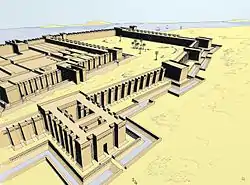
- Fortification – The world's first known fort is the fort of Tell El Sakan dating to the late predynastic period.[30]
- Catapult – A Catapult dating to the 19th century b.c. was found on the walls of the fortress of Buhen.[31]
- Draw bridge – The fortress of Buhen contains the oldest known drawbridges.[31]
- Battlements – Another feature of the Buhen fortress the construction of the world's oldest battlements.[31]
- Arrowslit – Loop holes are found for the first time in some Middle kingdom forts.[32]
- Escalade – Escalades appeared as early as the Middle Kingdom.[33]
- Battering rams – The earliest depiction of a possible battering ram is from the tomb of the 11th Dynasty noble Khety, where a pair of soldiers advance towards a fortress under the protection of a mobile roofed structure, carrying a long pole that may represent a simple battering ram.[34]
- Siege towers – Moving siege towers were invented in Egypt during the First Intermediate Period.[35]
- Naval ram – Naval rams were built on ships since at least the reign of Amenhotep I.[36]
- Dagger – In ancient Egypt, daggers were usually made of copper or bronze, while royalty had gold weapons. At least since pre-dynastic Egypt,[37] (c. 3100 BC) daggers were adorned as ceremonial objects with golden hilts and later even more ornate and varied construction. One early silver dagger was recovered with midrib design.
- Maces – Maces appeared in Egypt around 3600 B.C.[38]
- Police Dogs and War Dogs were used by the Egyptians as early as 4000 B.C.[39]
- Encryption – One of the earliest forms of encryption is symbol replacement, which was first found in the tomb of Khnumhotep II, who lived in 1900 B.C. Egypt. Symbol replacement encryption is “non-standard,” which means that the symbols require a cipher or key to understand.[40]
Agriculture and Animal Husbandry
- Irrigation system – From at least Pre-dynastic times, kings of the Dynasty 0 made the world's first organized irrigation system.[41][42]
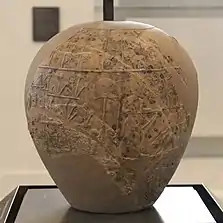
- Dam – King Narmer (3150 B.C.) built the walls of Memphis to function as a dam and protect the city from floods.[43]
- Diversion dam – The first Diversion dam is Sadd el-Kafara Dam built in Egypt around 2700 B.C.[44]
- Noria – Norias appeared in Egypt in the 4th Century B.C.[45]
- Beekeeping - Beekeeping was first recorded in ancient Egypt since pre-historic ages.[46]
- The first use of smoke while extracting the honey from bee nests is recorded in Ancient Egypt during the Old Kingdom.[47]
- Pet – The Ancient Egyptians were the first to keep animals in their homes as pets, believing they had magical properties.[48]
- Zoo – The world's first zoo was discovered at Hierakonpolis dating back to 3,500 B.C.[49]
- Olive cultivation – Some scholars have argued that olive cultivation originated with the Ancient Egyptians.[50][51]
- Ox drawn plough – Ox drawn ploughs were used by Ancient Egyptians as early as 2000 B.C.[52]
Transport
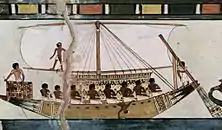
- Sail – Sail was invented in Egypt around 6,000BC.[54]
- Masts and Bipod mast – The bipod mast is a two-legged mast used originally in Egypt during the 3rd millennium BCE. It can be described as two poles secured together at the top, forming a thin isosceles triangle. It did not appear until the Old Kingdom, third dynasty, and disappeared after the sixth dynasty when the pole mast took over during the Middle Kingdom.[55]
- Rowing or Steering oar – A predecessor to the rudder. Rowing oars set aside for steering appeared on large Egyptian vessels long before the time of Menes (3100 BC).[56] In the Old Kingdom (2686 BC-2134 BC) as many as five steering oars are found on each side of passenger boats.[56]
- Tiller – The tiller, at first a small pin run through the stock of the steering oar, can be traced to the fifth dynasty (2504–2347 BC).[57] Both the tiller and the introduction of an upright steering post abaft reduced the usual number of necessary steering oars to one each side.[58]
- The world's earliest paved roads were discovered near Faiyum dating back to the 26th century BC.[59]
- Rail – Evidence from The Lake Meoris Quarry Road (26th century BC.) suggests the presence of early wooden rail using wooden logs to.[60][61]
Metals, Elements and Materials
- Emerald – Emerald was first mined in Egypt since at least the New Kingdom.[62]
- Iron – beads made from meteorite iron was discovered in Egypt dating to 3,500 BC. (22 centuries before the Iron Age).[63] Scarce Iron tools would be found in Egypt and throughout the third millennium BC.[64]
- Mercury – The earliest known use of Mercury dates to Ancient Egypt around 1500 BC.[65]
- Natron – Natron was used by the Ancient Egyptians in Mummification.[66][67]
- Turquoise – Turquoise was mined in Egypt Since at least the First Dynasty (3000 BCE), and possibly before then, turquoise was used by the Egyptians and was mined by them in the Sinai Peninsula. This region was known as the Country of Turquoise by the native Monitu.[68] Serabit el-Khadim and Wadi Maghareh, believed to be among the oldest of known mines.
- Wattle and daub – Wattle and daub was used in Egypt as early as the Merimde culture.[69]
- Lime mortar – The Ancient Egyptians were the first to use lime mortars. Which they used to plaster the pyramids at Giza. In addition, the Egyptians also incorporated various limes into their religious temples as well as their homes. Indian traditional structures built with lime mortar, which are more than 4,000 years old like Mohenjo-daro is still a heritage monument of Indus valley civilization in Pakistan.[70] It is one of the oldest known types of mortar also used in ancient Rome and Greece, when it largely replaced the clay and gypsum mortars common to ancient Egyptian construction.[71]
- Amethyst a form of quartz was first used by the Ancient Egyptians.[72]
- Malachite – Ancient Egyptians mined malachite at Maadi as early as the Old Kingdom.[73]
- Electrum – Electrum was used as early as the third millennium BC in Old Kingdom of Egypt, sometimes as an exterior coating to the pyramidions atop ancient Egyptian pyramids and obelisks. It was also used in the making of ancient drinking vessels. Electrum is mentioned in an account of an expedition sent by Pharaoh Sahure of the Fifth Dynasty of Egypt.[74][75]
- Other than that, the ancient Egyptians were the first to use gold (4000 BC.)[76] and lead (3800 BC.)[77] abundantly.
Discoveries
- Intracranial pulsations[78]
- Meninges[78]
- Cerebrospinal fluid[78]
- Paralysis[79]
- Urinary incontinence – The management of urinary incontinence with pads is mentioned in the earliest medical book known, the Ebers Papyrus (1500 BC).[80]
- Anatomy – In 1600 BCE, the Edwin Smith Papyrus, an Ancient Egyptian medical text, described the heart, its vessels, liver, spleen, kidneys, hypothalamus, uterus and bladder, and showed the blood vessels diverging from the heart. The Ebers Papyrus (c. 1550 BCE) features a "treatise on the heart", with vessels carrying all the body's fluids to or from every member of the body.[81]
- Circulatory system – The earliest known writings on the circulatory system are found in the Ebers Papyrus (16th century BCE), an ancient Egyptian medical papyrus containing over 700 prescriptions and remedies, both physical and spiritual. In the papyrus, it acknowledges the connection of the heart to the arteries. The Egyptians thought air came in through the mouth and into the lungs and heart. From the heart, the air travelled to every member through the arteries. Although this concept of the circulatory system is only partially correct, it represents one of the earliest accounts of scientific thought.[82]
- Cataract – Cataract was known in Ancient Egypt from at least the Fifth Dynasty.[83]
- Cancer – The earliest written record regarding cancer is from circa 1600 BC in the Egyptian Edwin Smith Papyrus and describes breast cancer.[84]
- Diabetes – Diabetes was one of the first diseases described,[85] with an Egyptian manuscript from c. 1500 BCE mentioning "too great emptying of the urine." The Ebers papyrus includes a recommendation for a drink to take in such cases.[86] The first described cases are believed to have been type 1 diabetes.[87]
- Dracunculiasis or Guinea-worm disease and its treatment – The Ebers Papyrus says that the cure to the Guinea-Worm disease is to wrap the emerging end of the worm around a stick and slowly pull it out. 3,500 years later, this remains the standard treatment.[88]
- Hysteria – The oldest record of hysteria dates back to 1900 B.C. when Egyptians recorded behavioral abnormalities in adult women on medical papyrus.[89] The Egyptians attributed the behavioral disturbances to a wandering uterus—thus later dubbing the condition hysteria.[89] To treat hysteria Egyptian doctors prescribed various medications.[89] For example, doctors put strong smelling substances on the patients’ vulvas to encourage the uterus to return to its proper position.[89] Another tactic was to smell or swallow unsavory herbs to encourage the uterus to flee back to the lower part of the female's stomach.[89]
- Hematuria – One of the main symptoms of Bilharzia was known and treated by the ancient Egyptians.[90]
- Baldness – The Ebers papyrus contain several remedies to cure hair loss.[91]
- Colorectal surgery – The Chester Beatty Medical Papyrus, is one of the extant medical papyri, from ancient Egypt. It is dedicated to magical incantations against headaches and remedies for anorectal ailments,[92] and is dated around 1200 BC.
Inventions
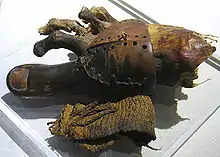
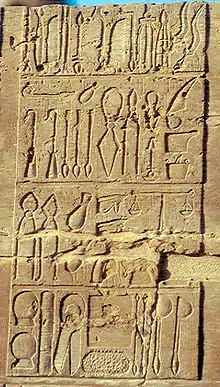
- Bandage – The Ancient Egyptians were the first to use adhesive bandages and were also the first to treat wounds with Honey.[93][94]
- Prosthesis – Prosthetics appeared circa 3,000 BC. with the earliest evidence of prosthetics appearing in ancient Egypt and Iran. The earliest recorded mention of eye prosthetics is from the Egyptian story of the Eye of Horus dates circa 3000 BC, which involves the left eye of Horus being plucked out and then restored by Thoth. The Egyptians were also early pioneers of foot prosthetics, as shown by the wooden toe found on a body from the New Kingdom circa 1000 BC.[95]
- Cauterization – Cauterization has been used to stop heavy bleeding since antiquity. The process was described in the Edwin Smith Papyrus.
- Surgical instruments – The oldest metal (Bronze[96] or copper[97][98]) surgical tools[99] in the world were discovered in the tomb of Qar.
- Scalpel[100]
- Bone cutter[100]
- Suction cups[100]
- Retractor[100]
- Syringe[100]
- Forceps[100]
- Sponge Phials[100]
- Clamps – Used to stop blood flow.[100]
- Toothpaste and Toothbrush – Since 5000 BC, the Egyptians made a tooth powder, which consisted of powdered ashes of ox hooves, myrrh, powdered and burnt eggshells, and pumice.[101]
- Breath mint[102]
Innovations
- Gynaecology – The Kahun Gynaecological Papyrus, dated to about 1800 BC, deals with women's health gynaecological diseases, fertility, pregnancy, contraception, etc. Treatments are non surgical, comprising applying medicines to the affected body part or swallowing them. The womb is at times seen as the source of complaints manifesting themselves in other body parts.[103]
- Pregnancy test – The ancient Egyptians watered bags of wheat and barley with the urine of a possibly pregnant woman. Germination indicated pregnancy. The type of grain that sprouted was taken as an indicator of the fetus's sex.[104]
- Birth control – The Egyptian Ebers Papyrus from 1550 BC and the Kahun Papyrus from 1850 BC have within them some of the earliest documented descriptions of birth control: the use of honey, acacia leaves and lint to be placed in the vagina to block sperm.[105][106]
- Rhinoplasty – Treatments for the plastic repair of a broken nose are first mentioned in the Edwin Smith Papyrus,[107] a transcription of text dated to the Old Kingdom from 3000 to 2500 BCE.[108]
- Surgical suture – The earliest reports of surgical suture date to 3000 BC in ancient Egypt, and the oldest known suture is in a mummy from 1100 BC.[109]
- Ophthalmology – In the Ebers Papyrus from ancient Egypt dating to 1550 BC, a section is devoted to eye diseases.[110]
Algebra
- Numeral system – Written evidence of the use of mathematics dates back to at least 3200 BC with the ivory labels found in Tomb U-j at Abydos. These labels appear to have been used as tags for grave goods and some are inscribed with numbers.[111] Further evidence of the use of the base 10 number system can be found on the Narmer Macehead which depicts offerings of 400,000 oxen, 1,422,000 goats and 120,000 prisoners.[112]
- Base-10 numeral system

- Binary – The method used for ancient Egyptian multiplication is also closely related to binary numbers. In this method, multiplying one number by a second is performed by a sequence of steps in which a value (initially the first of the two numbers) is either doubled or has the first number added back into it; the order in which these steps are to be performed is given by the binary representation of the second number. This method can be seen in use, for instance, in the Rhind Mathematical Papyrus, which dates to around 1650 BC.[113][114]
- Fraction and Arithmetics with fractions – The earliest fractions were reciprocals of integers: ancient symbols representing one part of two, one part of three, one part of four, and so on.[115] The Egyptians used Egyptian fractions c. 1000 BC. About 4000 years ago, Egyptians divided with fractions using slightly different methods. They used least common multiples with unit fractions. Their methods gave the same answer as modern methods.[116]
- Dyadic rational – The Egyptians also had a different notation for dyadic fractions in the Akhmim Wooden Tablet and several Rhind Mathematical Papyrus problems.[117]
- X (Unknown)
- Quadratic equation – The ancient Egyptians were the first civilization to develop and solve second-degree (quadratic) equations. This information is found in the Berlin Papyrus fragment. Additionally, the Egyptians solve first-degree algebraic equations found in Rhind Mathematical Papyrus.[118]
- Exponentiation (Power of two) – The ancient Egyptians had laid out tables of a great number of powers of two, rather than recalculating them each time. The decomposition of a number thus consists of finding the powers of two which make it up. The Egyptians knew empirically that a given power of two would only appear once in a number.[119]
- Regula falsi – The simple false position technique is found in papyri from ancient Egyptian mathematics.[120]
- Square root – The Rhind Mathematical Papyrus is a copy from 1650 BC of an earlier Berlin Papyrus and other texts – possibly the Kahun Papyrus – that shows how the Egyptians extracted square roots by an inverse proportion method.[121]
- 0 – By 1770 BC, the Egyptians had a symbol for zero in accounting texts. The symbol nfr, meaning beautiful, was also used to indicate the base level in drawings of tombs and pyramids and distances were measured relative to the base line as being above or below this line.[122]
- Mathematical symbols – The Egyptian hieroglyphic sign for addition resembled a pair of legs walking in the direction in which the text was written (Egyptian could be written either from right to left or left to right), with the reverse sign indicating subtraction:[123]
- Pi – Based on the measurements of the Great Pyramid of Giza (c. 2560 BC) ,[lower-alpha 1] some Egyptologists have claimed that the ancient Egyptians used an approximation of π as 22/7 from as early as the Old Kingdom.[124][125] The Rhind Papyrus, dated around 1650 BC but copied from a document dated to 1850 BC, has a formula for the area of a circle that treats π as (16/9)2 ≈ 3.16.
- The Golden number[126]
- Arithmetic progression – Rhind Mathematical Papyrus problem number 40.[127]
- Pefsu problem (modern day: Arithmetic mean)[128]
- Conversion of units – Rhind Mathematical Papyrus problem number 42.[127]
- Seked (Modern day Slope) – The seked is proportional to the reciprocal of our modern measure of slope or gradient, and to the cotangent of the angle of elevation.[129][130]
- Trigonometry and Trigonometric functions – Rhind Mathematical Papyrus problem number 56. The Egyptians, used a primitive form of trigonometry for building pyramids in the 2nd millennium BC.[131]
- Red auxiliary number – Red auxiliary numbers were written in red ink in the Rhind Mathematical Papyrus, apparently used as aids for arithmetic computations involving fractions.[132][133]
Areas and Volumes
- Area of Triangle – Rhind Mathematical Papyrus problem number 51.[127]
- Area of Circle - Calculated during the calculation of the volume of the cylinder
- Area of Trapezoid – Rhind Mathematical Papyrus problem number 52.[127]
- Surface area of Sphere – The Tenth problem of the Moscow Mathematical Papyrus asks for a calculation of the surface area of a hemisphere (Struve, Gillings) or possibly the area of a semi-cylinder (Peet). Below we assume that the problem refers to the area of a hemisphere.[134]
- Volume of Cylinder – Rhind Mathematical Papyrus problem number 41.[127]
- Volume of Prism – Rhind Mathematical Papyrus problem number 46.[127]
- Volume of Pyramid[135]
- Volume of Frustum – The 14th problem of the Moscow Mathematical Papyrus calculates the volume of a frustum. Problem 14 states that a pyramid has been truncated in such a way that the top area is a square of length 2 units, the bottom a square of length 4 units, and the height 6 units, as shown. The volume is found to be 56 cubic units, which is correct.[136]
Measurement
- System of measurement and Metrology – Ancient Egypt was one of the first civilization to have system of measurement.[137] The Ancient Egyptian measuring system contained measuring units for:
- Length – Egyptian units of length are attested from the Early Dynastic Period. Although it dates to the 5th dynasty, the Palermo stone recorded the level of the Nile River during the reign of the Early Dynastic pharaoh Djer, when the height of the Nile was recorded as 6 cubits and 1 palm (about 3.217 m or 10 ft 6.7 in). A 3rd Dynasty diagram shows how to construct an elliptical vault using simple measures along an arc. The ostracon depicting this diagram was found near the Step Pyramid of Saqqara. A curve is divided into five sections and the height of the curve is given in cubits, palms, and digits in each of the sections.[138]

- Area – Records of land area also date to the Early Dynastic Period. The Palermo stone records grants of land expressed in terms of kha and setat. Mathematical papyri also include units of land area in their problems. For example, several problems in the Moscow Mathematical Papyrus give the area of rectangular plots of land in terms of setat and the ratio of the sides and then require the scribe to solve for their exact lengths.[139]
- Volume[139]
- Weight – Weighs were known since the Old Kingdom and perhaps as early as the Early Dynastic Period. Weights were measured in terms of deben. This unit would have been equivalent to 13.6 grams in the Old Kingdom and Middle Kingdom. During the New Kingdom however it was equivalent to 91 grams. For smaller amounts the qedet (1⁄10 of a deben) and the shematy (1⁄12 of a deben) were used.[140]
Science
- Geology – The earliest detailed map known in the world from the Turin Papyrus dating to Ramesside Period about 1160 BCE, shows the route to the gold mines in the Wadi Hammamat, Eastern Desert.[141]
- Topography – Besides being a Geological map of surprisingly modern aspect, the Turin Papyrus is also a topographic map (the earliest known) because it accurately shows the local distribution of different rock types (with black and pink hills), the lithologically diverse wadi gravels (with brown, green and white dots), and it contains information on quarrying and mining. The draughtsman clearly and carefully distributed distinctive features in accordance with the reality of a particular area, adding clarity by the use of legends and contrasting colors. In this respect, the Turin Papyrus may be regarded as the earliest known Geographic Information System.[142][143]
Astronomy
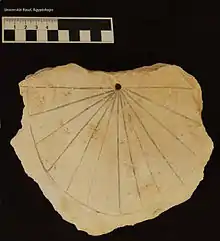
- Mural instrument
- Decan – Decans are 36 groups of stars (small constellations) used in the Ancient Egyptian astronomy. They rose consecutively on the horizon throughout each earth rotation. The rising of each decan marked the beginning of a new decanal "hour" (Greek hōra) of the night for the ancient Egyptians, and they were used as a sidereal star clock beginning by at least the 9th or 10th Dynasty (c. 2100 BCE).[144]
- The discovery of Algol – An Ancient Egyptian Calendar of Lucky and Unlucky Days composed some 3,200 years ago is claimed to be the oldest historical document of the discovery of Algol.[145][146][147]
- Sothic cycle
- Calendar[148]
- Star clock[149]
- Solstice and Equinox[150]
- Sundials – The earliest sundials known from the archaeological record are shadow clocks (1500 BC or BCE) from ancient Egyptian astronomy.[151]
Tools and machines
- Core drill – The earliest core drills were those used by the ancient Egyptians, invented in 3000 BC.[152]
- Dock – The earliest known docks were those discovered in Wadi al-Jarf, an ancient Egyptian harbor, of Pharaoh Khufu, dating from c.2500 BC located on the Red Sea coast.[153][154] Archaeologists also discovered anchors and storage jars near the site.[155]
- Herodotus Machine – The Herodotus Machine was a machine described by Herodotus, a Greek historian. Herodotus claims this invention enabled the ancient Egyptians to construct the pyramids. The contraption supposedly allowed workers to lift heavy building materials. Herodotus is believed to have encountered the device while traveling through Egypt. With limited reference and no true schematics, this machine has stimulated many historians' theories of how the Ancient Egyptians were able to create pyramids.[156]
- Lever – Levers (as machines used in lifting heavy weights) were invented in Ancient Egypt. In ancient Egypt technology, workmen used the lever to move and uplift obelisks weighing more than 100 tons. This is evident from the recesses in the large blocks and the handling bosses which could not be used for any purpose other than for levers.[157]
- Loom – Looms were used in ancient Egypt as early as 4400 BC, a foot pedal was used for the earliest horizontal frame loom.[158]

- Papyrus Paper – Papyrus paper was first manufactured in Egypt as far back as the fourth millennium BCE.[159][160][161] The earliest archaeological evidence of papyrus was excavated in 2012 and 2013 at Wadi al-Jarf, an ancient Egyptian harbor located on the Red Sea coast. These documents, the Diary of Merer, date from c. 2560–2550 BCE (end of the reign of Khufu).[160] The papyrus rolls describe the last years of building the Great Pyramid of Giza.[162]
- Ink – Ink was used in Ancient Egypt for writing and drawing on papyrus from at least the 26th century BC.[160]
- Pulley – The earliest evidence of pulleys date back to Ancient Egypt in the Twelfth Dynasty (1991–1802 BCE)[163]
- Rope stretcher – a rope stretcher (or harpedonaptai) was a surveyor who measured real property demarcations and foundations using knotted cords, stretched so the rope did not sag. The practice is depicted in tomb paintings of the Theban Necropolis.[164] rope-stretching itself, are attested over 3000 years from the early dynastic period to the Ptolemaic kingdom.[165]
- Plumb bob – The Plumb bob has been used since at least the time of ancient Egypt[166]
- Ostracon – The Saqqara ostracon is an ostracon, an Egyptian antiquity, tracing to the period of Djoser (2650 BC),[167]
- Siphon – Ancient Egyptian reliefs from 1500 BC depict siphons used to extract liquids from large storage jars.[168][169]
- The oldest known sundial is from Egypt; it dates back to around 1500 BC (19th Dynasty), and was discovered in the Valley of the Kings in 2013.[170] Sundials have their origin in shadow clocks, which were the first devices used for measuring the parts of a day.[171] Ancient Egyptian obelisks, constructed about 3500 BC, are also among the earliest shadow clocks.[172][173]
- Water clock – The oldest water clock of which there is physical evidence dates to c. 1417–1379 BC, during the reign of Amenhotep III where it was used in the Temple of Amen-Re at Karnak.[174] The oldest documentation of the water clock is the tomb inscription of the 16th century BC Egyptian court official Amenemhet, which identifies him as its inventor.[175][176]
- Wig – In Egyptian society men and women commonly had clean shaven or close cropped hair and often wore wigs.[177][178] The ancient Egyptians created the wig to shield shaved, hairless heads from the sun. They also wore the wigs on top of their hair using beeswax and resin to keep the wigs in place. Wealthy Egyptians would wear elaborate wigs and scented cones of animal fat on top of their wigs.[177]
- Ramps and Inclined planes – The Egyptian pyramids were constructed using inclined planes,[179][180][181]
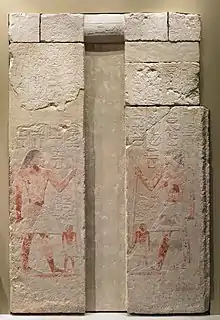
- Parchment – Writing on prepared animal skins had a long history, however. David Diringer noted that "the first mention of Egyptian documents written on leather goes back to the Fourth Dynasty (c. 2550–2450 BC), but the earliest of such documents extant are: a fragmentary roll of leather of the Sixth Dynasty (c. 24th century BC), unrolled by Dr. H. Ibscher, and preserved in the Cairo Museum; a roll of the Twelfth Dynasty (c. 1990–1777 BC) now in Berlin; the mathematical text now in the British Museum (MS. 10250); and a document of the reign of Ramses II (early thirteenth century BC)."[182]
- Doors and Door Locks[183] – The earliest in records are those represented in the paintings of some ancient Egyptian tombs, in which they are shown as single or double doors, each in a single piece of wood. Doors were once believed to be the literal doorway to the afterlife, and some doors leading to important places included designs of the afterlife.
- Combs[184]
- Bellows – Bellows were used as early as the New Kingdom.[185]
- Air conditioning – The basic concept behind air conditioning is said to have been applied in ancient Egypt, where reeds were hung in windows and were moistened with trickling water. The evaporation of water cooled the air blowing through the window. This process also made the air more humid, which can be beneficial in a dry desert climate.[186]
- Hand fan – Hand fans had been used in Egypt as early as 4,000 years ago. Hand fans have been found in King Tut's tomb.[187]
- Pens and Reed pens – Ancient Egyptians had developed writing on papyrus scrolls when scribes used thin reed brushes or reed pens from the Juncus maritimus or sea rush.[188] In his book A History of Writing, Steven Roger Fischer suggests that on the basis of finds at Saqqara, the reed pen might well have been used for writing on parchment as long ago as the First Dynasty or about 3000 BC.
- Spoon – Preserved examples of various forms of spoons used by the ancient Egyptians include those composed of ivory, flint, slate and wood; many of them carved with religious symbols.[189][190]
- Scissors[191][192]
- Set square – Found the tomb of architect Kha.[193]
- Protractors – Found the tomb of architect Kha.[193]
- Copper Pipes – The c.2400 BCE, Pyramid of Sahure, and adjoining temple complex at Abusir, was discovered to have a network of copper drainage pipes.[194]
- Archimedes' screw – Although commonly attributed to Archimedes, the device had been used in Ancient Egypt long before his time.[195] The first records of a water screw, or screw pump, date back to Ancient Egypt before the 3rd century BC.[196] The Egyptian screw, used to lift water from the Nile, was composed of tubes wound round a cylinder; as the entire unit rotates, water is lifted within the spiral tube to the higher elevation. A later screw pump design from Egypt had a spiral groove cut on the outside of a solid wooden cylinder and then the cylinder was covered by boards or sheets of metal closely covering the surfaces between the grooves.
- Screw pump – The screw pump is the oldest positive displacement pump.[197] The first records of a water screw, or screw pump, dates back to Ancient Egypt before the 3rd century BC.[196] The Egyptian screw, used to lift water from the Nile, was composed of tubes wound round a cylinder; as the entire unit rotates, water is lifted within the spiral tube to the higher elevation. A later screw pump design from Egypt had a spiral groove cut on the outside of a solid wooden cylinder and then the cylinder was covered by boards or sheets of metal closely covering the surfaces between the grooves.
Furniture
Furniture became common first in Ancient Egypt during the Naqada culture.[198] During that period a wide variety of furniture pieces were invented and used.
- Tables – Some very early tables were made and used by the ancient Egyptians[199] around 2500 BC, using wood and alabaster.[200] They were often little more than stone platforms used to keep objects off the floor, though a few examples of wooden tables have been found in tombs. Food and drinks were usually put on large plates deposed on a pedestal for eating. The Egyptians made use of various small tables and elevated playing boards.
- Chairs – Chairs were in existence since at least the Early Dynastic Period of Egypt (c. 3100 BC). They were covered with cloth or leather, were made of carved wood, and were much lower than today's chairs – chair seats were sometimes only 10 inches (25 cm) high.[201]
- Bed – The Egyptians had high bedsteads which were ascended by steps, with bolsters or pillows, and curtains to hang around. The elite of Egyptian society such as its pharaohs and queens even had beds made of wood, sometimes gilded. Often there was a head-rest as well, semi-cylindrical and made of stone, wood, or metal.[202][203]
Architecture
- Mastaba – Was a predecessor to the Egyptian pyramid. Kings of the Early Dynastic Period were buried there.
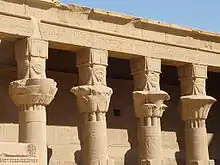
- Column – In ancient Egyptian architecture as early as 2600 BC, the architect Imhotep made use of stone columns whose surface was carved to reflect the organic form of bundled reeds, like papyrus, lotus and palm. In later Egyptian architecture faceted cylinders were also common. Their form is thought to derive from archaic reed-built shrines. Carved from stone, the columns were highly decorated with carved and painted hieroglyphs, texts, ritual imagery and natural motifs. Egyptian columns are famously present in the Great Hypostyle Hall of Karnak (circa 1224 BC), where 134 columns are lined up in sixteen rows, with some columns reaching heights of 24 metres.
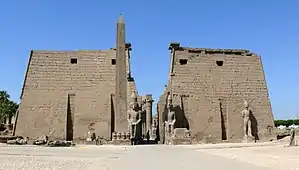
- Hypostyle Architecture
- Capital – The two earliest Egyptian capitals of importance are those based on the lotus and papyrus plants.
- Pylon – Pylons were often decorated with scenes emphasizing a king's authority since it was the public face of a cult building.[204] On the first pylon of the temple of Isis at Philae, the pharaoh is shown slaying his enemies while Isis, Horus and Hathor look on. Other examples of pylons can be seen in Karnak, Luxor, and Edfu.
- Obelisk – The earliest temple obelisk still in its original position is the 68-foot (20.7 m) 120-metric-ton (130-short-ton)[205] red granite Obelisk of Senusret I of the XIIth Dynasty at Al-Matariyyah in modern Heliopolis.[206]

- Gardens – Gardens appeared in Egypt during the Old Kingdom. There were many types of gardens in Ancient Egypt such as: pleasure gardens, Palace gardens, Temple gardens and Funerary gardens.[207]
- Cavetto – Ancient Egyptian architecture made special use of large cavetto mouldings as a cornice, with only a short fillet (plain vertical face) above, and a torus moulding (convex semi-circle) below. This cavetto cornice is sometimes also known as an "Egyptian cornice", "hollow and roll" or "gorge cornice", and has been suggested to be a reminiscence in stone architecture of the primitive use of bound bunches of reeds as supports for buildings, the weight of the roof bending their tops out.[208]
Crafts
- Wood carving and Wooden statues – The extreme dryness of the climate of Egypt accounts for the existence of a number of woodcarvings from this remote period. Some wood panels from the tomb of Hosul Egypt, at Sakkarah are of the III. dynasty. The carving consists of Egyptian hieroglyphs and figures in low relief, and the style is extremely delicate and fine. A stool shown on one of the panels has the legs shaped like the fore and hind limbs of an animal, a form common in Egypt for thousands of years.
- Hollow Glass Production and Glassware – Egypt and Mesopotamia were the first civilizations to produce glass works(3,500 BC.). After 1,500 BC. Egyptian craftsmen started to make hollow glass pots.
- Egyptian faience
- Cosmetic palette
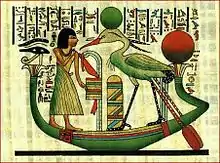
- Watercolor paper – Painting on Papyrus was invented in Ancient Egypt long before the invention of Paper.
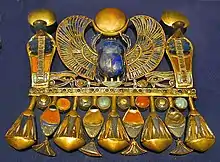
- Blue dye and Synthetic dyes – In Egypt, blue was used for the eyebrows on the funeral mask of King Tutankhamun (1341–1323 BC).[209] Importing lapis lazuli by caravan across the desert from Afghanistan to Egypt was very expensive. Beginning in about 2500 BC, the ancient Egyptians began to produce their own blue pigment known as Egyptian blue by grinding silica, lime, copper, and alkalai, and heating it to 800 or 900 °C (1,470 or 1,650 °F). This is considered the first synthetic pigment.[210] Egyptian blue was used to paint wood, papyrus and canvas, and was used to colour a glaze to make faience beads, inlays, and pots. It was particularly used in funeral statuary and figurines and in tomb paintings.
- Pectoral – The pectorals of ancient Egypt were a form of jewelry, often represented as a brooch. These were mostly worn by richer people and the pharaoh.
Music and Dance
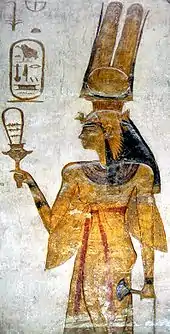
- Ceremonial dance
- Pair Dancing – In pair dancing, two people of the same gender would perform together.[211] This form of dancing was established by the 6th dynasty.
- Group Dancing – There were two types of Egyptian group dances. One was performed in individual movements that confirmed a theme or idea or was carried out spontaneously as in prehistoric times. Dancers competed with one another, often in groups, substituting movement that were later established in funeral dances rites.
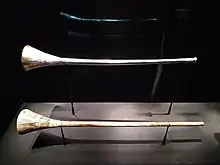
- Tambourines
- Sistrum – The sistrum was a sacred instrument in ancient Egypt. Perhaps originating in the worship of Bastet, it was used in dances and religious ceremonies, particularly in the worship of the goddess Hathor, with the U-shape of the sistrum's handle and frame seen as resembling the face and horns of the cow goddess.[212]
- Cymbals
- Double reed – Double reeds are used in making instruments in Ancient Egypt as early as 3300 BC.
- Trumpet – The earliest trumpets date back to 1500 BC and earlier. The bronze and silver trumpets from Tutankhamun's grave in Egypt.
- Clarinet[213]
- Melisma – According to Demetrius of Falorene (3rd century A.D), The Egyptian priests used to praise the gods by singing 7 vowels successively producing sweet sounds. This is the first mention of the melisma which is used in many of the Coptic hymns today.[214]
- Syllabtic music style – The Syllabtic music style had been used for 2000 years in the coptic church "Tasbe7a".[215]
Literature
- Written records – The Ancient Egyptian sentence found in the tomb of Seth-Peribsen is the world's oldest known sentence[216]
- Short story and Story telling – Story-telling started in Ancient Egypt around 200 BC. Among the oldest known stories the "Story of Sinuhe" and the "Tale of the Shipwrecked Sailor".
- Epistle – The ancient Egyptians wrote epistles, most often for pedagogical reasons. Egyptologist Edward Wente (1990) speculates that the Fifth Dynasty Pharaoh Djedkare Isesi (in his many letters sent to his viziers) was a pioneer in the epistolary genre.[217]
- Sebayt and Wisdom literature – The Maxims of Ptahhotep are among the oldest pieces of wisdom literature. It was compiled during the 24th century BC.[218]
Sports
- Bowling – The earliest known forms of bowling date back to ancient Egypt,[220] with wall drawings depicting bowling being found in a royal Egyptian tomb dated to 5200 B.C.[221] and miniature pins and balls in an Egyptian child's grave about 5200 B.C.[222] Remnants of bowling balls were found among artifacts in ancient Egypt going back to the Egyptian protodynastic period in 3200 BC.[223] What is thought to be a child's game involving porphyry (stone) balls, a miniature trilithon, and nine breccia-veined alabaster vase-shaped figures—thought to resemble the more modern game of skittles—was found in Naqada, Egypt in 1895.[219]
- Hockey – Drawings on tombs at Beni Hassan in Menia Governorate show players holding bats made of long palm-tree branches, with a bent end similar to that of the hockey bat. The hockey ball was made of compressed papyrus fibers covered with two pieces of leather in the shape of a semicircle.[224][225]
- Handball – Drawings of this sport are found on the Saqqara tombs, five thousand years old. The ball was made of leather and stuffed with plant fibers or hay, or made of papyrus plants in order to be light and more durable. It was seldom used for more than one match.[224]
- Gymnastics – Ancient Egyptians were the first to play Gymnastics. They even developed three types of Gymnastics which are: Rhythmic Gymnastics,[226] Gymnastics: Consecutive Vault[227] and floor gymnastics.[228]
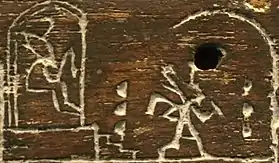
- Weightlifting – Weightlifting was first recorded in ancient Egypt. One method of weightlifting was lifting a heavy sack of sand with one hand and keep it high in a vertical position. The player had to hold that sack of sand for some time and stay in the same position. This rule is still applied in the modern weightlifting.[229][225]
- High jump[225]
- Tug of War – This sport was practiced in the country side.[230][225]
- Tug of Hoop[225][231]
- Equilibrium (sport)[225][232]
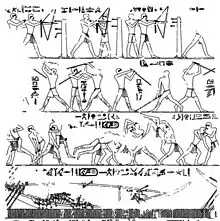
- Running – Although running was very common in prehistoric times, running races began in Ancient Egypt during the Heb-sed festival as early as 3000 BC.
- Fencing – The first historical evidence from archaeology of a fencing contest was found on the wall of a temple within Egypt built at a time dated to approximately 1190 B.C.[233]
- Tahtib – The oldest traces of tahtib were found on engravings from the archaeological site of Abusir, an extensive necropolis of the Old Kingdom period, located in the south-western suburbs of Cairo. On some of the reliefs of the Pyramid of Sahure (V dynasty, c. 2500 BC);[234] the images and explanatory captions are particularly precise and accurate in their depiction of what seems to be military training using sticks. Tahtib, with archery and wrestling, was then among the three disciplines of warfare taught to soldiers.
Cuisine
- Frying – Frying is believed to have first appeared in the ancient Egyptian kitchen, during the Old Kingdom, around 2500 BCE.[235]
- Banquet – Depictions of banquets can be found in paintings from both the Old Kingdom and New Kingdom. They usually started sometime in the afternoon. Men and women were separated unless they were married. Seating varied according to social status, with those of the highest status sitting on chairs, those slightly lower sat on stools and those lowest in rank sat on the raw floor. Before the food was served, basins were provided along with aromatics and cones of scented fat were lit to spread pleasant smells or to repel insects, depending on the type.[236]
- Lettuce – Lettuce was first cultivated in ancient Egypt for the production of oil from its seeds. This plant was probably selectively bred by the Egyptians into a plant grown for its edible leaves,[237] with evidence of its cultivation appearing as early as 2680 BC. Lettuce was considered a sacred plant of the reproduction god Min, and it was carried during his festivals and placed near his images. The plant was thought to help the god "perform the sexual act untiringly."[238] Its use in religious ceremonies resulted in the creation of many images in tombs and wall paintings. The cultivated variety appears to have been about 75 cm (30 in) tall and resembled a large version of the modern romaine lettuce. These upright lettuces were developed by the Egyptians and passed to the Greeks, who in turn shared them with the Romans.
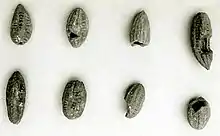
- Foie gras and force-feeding – The technique of gavage dates as far back as 2500 BC, when the ancient Egyptians began keeping birds for food and deliberately fattened the birds through force-feeding.[239] Today, France is by far the largest producer and consumer of foie gras, though it is produced and consumed worldwide, particularly in other European nations, the United States, and China.[240]
- Hardtack and Biscuits – versions using various grains date back to Ancient Rome, and as far back as Ancient Egypt.[241]
- Smy – thickened milk[lower-alpha 2] documented as existent in ancient Egypt.
- Egyptian cheese - Archaeological evidence for making cheese in Egypt goes back about 5,000 years. In 2018, archeologists from Cairo University and the University of Catania reported the discovery of the oldest known cheese from Egypt. Discovered in the Saqqara necropolis, it is around 3200 years old.[243] Earlier, remains identified as cheese were found in the funeral meal in an Egyptian tomb dating around 2900 BC.[244] Visual evidence of Egyptian cheesemaking was found in Egyptian tomb murals in approximately 2000 BC.[245]
- Yeast, Dough and Leavened bread – The earliest definite records of yeast come from Ancient Egypt.[246]
- Desserts and Pies – During the Egyptian Neolithic period or New Stone Age period, the use of stone tools shaped by polishing or grinding, the domestication of plants and animals, the establishment of permanent villages, and the practice of crafts such as pottery and weaving became common. Early pies were in the form of flat, round or freeform crusty cakes called galettes consisting of a crust of ground oats, wheat, rye, or barley containing honey inside. These galettes developed into a form of early sweet pastry or desserts, evidence of which can be found on the tomb walls of the Pharaoh Ramesses II, who ruled from 1304 to 1237 BC, located in the Valley of the Kings.
- Boiled eggs – In Thebes, Egypt, the tomb of Haremhab, dating to approximately 1420 BCE, shows a depiction of a man carrying bowls of ostrich eggs and other large eggs, presumably those of the pelican, as offerings.[247] In ancient Rome, eggs were preserved using a number of methods and meals often started with an egg course.
- Marshmallows – The first marshmallows were produced in Egypt around 2000 B.c. and were made by mixing Mallow sap, honey, grains and baked into cakes. Marshmallows were only served to the Gods of Ancient Egypt and pharaohs, as a candy or a dessert.[248][249]
Clothing and Cosmetics
- Glove[250]
- Crown – Royal headdress was used in Egypt since the Predyanstic times. The king of Lower Egypt wore the Deshret crown while the king of Upper Egypt wore Hedjet. The Deshret and the Hedjet were found in Egyptian inscriptions as early as 3500 BC.[251]
- Shirt – The world's oldest preserved garment, discovered by Flinders Petrie, is a "highly sophisticated" linen shirt from a First Dynasty Egyptian tomb at Tarkan, dated to c. 3000 BC: "the shoulders and sleeves have been finely pleated to give form-fitting trimness while allowing the wearer room to move. The small fringe formed during weaving along one edge of the cloth has been placed by the designer to decorate the neck opening and side seam."[252]
- Hat – One of the first pictorial depictions of a hat appears in a tomb painting from Thebes, Egypt, which shows a man wearing a conical straw hat, dated to around 3200 BC. Hats were commonly worn in ancient Egypt. Many upper-class Egyptians shaved their heads, then covered it in a headdress intended to help them keep cool.
- Umbrella – he earliest known parasols in Ancient Egyptian art date back to the Fifth Dynasty, around 2450 BC.[253] The parasol is found in various shapes. In some instances it is depicted as a flabellum, a fan of palm-leaves or coloured feathers fixed on a long handle, resembling those now carried behind the Pope in processions.
- Hairpin – Hairpins made of metal, ivory, bronze, carved wood, etc. were used in ancient Egypt[254] for securing decorated hairstyles. Such hairpins suggest, as graves show, that many were luxury objects among the Egyptians and later the Greeks, Etruscans, and Romans.
- Shaving and Hygiene
- Cosmetics
- Kohl[255]
- Liniment – made from Castor oil.[255]
- Henna and Hair dye – Ancient Egyptian, Ahmose-Henuttamehu (17th Dynasty, 1574 BCE): was probably a daughter of Seqenenre Tao and Ahmose Inhapy. Smith reports that the mummy of Henuttamehu's own hair had been dyed a bright red at the sides, probably with henna.[256]
- Perfume – Evidence from jars dating back to 3000 B.C. with remains of mixtures of oils and fats indicates the use of perfumes by the Ancient Egyptians in the Early bronze age.[257][258]
- High-heeled shoe – Paintings circa 3,500 BC. show images of men and women wearing high-heeled shoes. High-heeled shoes was also used by butchers to make them move easily over the dead animals.[259]
Others
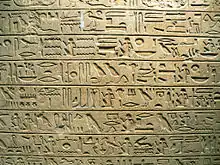
- Egyptian hieroglyphs – Hieroglyphic symbol systems developed in the second half of the 4th millennium BC, such as the clay labels of a Predynastic ruler called "Scorpion I" (Naqada IIIA period, c. 33rd century BC) recovered at Abydos (modern Umm el-Qa'ab) in 1998 or the Narmer Palette (c. 31st century BC).[260]
- Hieratic – Hieratic developed as a cursive form of hieroglyphic script in the Naqada III period, roughly 3200–3000 BCE.[261]
- Demotic – Early Demotic (often referred to by the German term Frühdemotisch) developed in Lower Egypt during the later part of the Twenty-fifth Dynasty, particularly found on steles from the Serapeum at Saqqara.
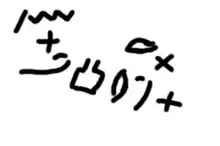
- Alphabet – The history of the alphabet started in ancient Egypt. Egyptian writing had a set of some 24 hieroglyphs that are called uniliterals,[262] to represent syllables that begin with a single consonant of their language, plus a vowel (or no vowel) to be supplied by the native speaker. These glyphs were used as pronunciation guides for logograms, to write grammatical inflections, and, later, to transcribe loan words and foreign names.[263] In the Middle Bronze Age, an apparently "alphabetic" system known as the Proto-Sinaitic script appears in Egyptian turquoise mines in the Sinai peninsula dated to circa the 15th century BC, apparently left by Canaanite workers. In 1999, John and Deborah Darnell discovered an even earlier version of this first alphabet at Wadi el-Hol dated to circa 1800 BC and showing evidence of having been adapted from specific forms of Egyptian hieroglyphs that could be dated to circa 2000 BC, strongly suggesting that the first alphabet had been developed about that time.[264] Based on letter appearances and names, it is believed to be based on Egyptian hieroglyphs.[265] This script had no characters representing vowels, although originally it probably was a syllabary, but unneeded symbols were discarded.
- Rubric – red ink was used by Ancient Egyptians to emphasize an important text.

- Mehen – Evidence of the game of Mehen is found from the Predynastic period dating from approximately 3000 BC and continues until the end of the Old Kingdom, around 2300 BC.[266]
- Senet – Senet, found in Predynastic and First Dynasty burials of Egypt, c. 3500 BC and 3100 BC respectively,[267] is the oldest board game known to have existed. Senet was pictured in a fresco found in Merknera's tomb (3300–2700 BC).[268][269]
- Dice – The Egyptian game of senet was played with flat two-sided throwsticks which indicated the number of squares a player could move, and thus functioned as a form of dice. Senet was played before 3000 BC and up to the 2nd century AD.[270]
- Surveying – Surveying has occurred since humans built the first large structures. In ancient Egypt, a rope stretcher would use simple geometry to re-establish boundaries after the annual floods of the Nile River. The almost perfect squareness and north–south orientation of the Great Pyramid of Giza, built c. 2700 BC, affirm the Egyptians' command of surveying.
- Histiography and King lists – The pharaohs of Egypt used to glorify their ancestors. The Den seal impressions is the oldest King list in the world dating to 3000 BC.[271] The Palermo Stone is one of seven surviving fragments of a stele known as the Royal Annals of the Old Kingdom of Ancient Egypt. The stele contained a list of the kings of Egypt from the First Dynasty (~3150–2890 BCE) through to the early part of the Fifth Dynasty (approx 2392–2283 BCE) and noted significant events in each year of their reigns. It was probably made during the Fifth Dynasty.[272] These inscriptions are considered as the oldest History studies.
- Logbooks – The Diary of Merer (Papyrus Jarf A and B) is the name for papyrus logbooks written over 4,500 years ago that record the daily activities of stone transportation from the Tura limestone quarry to and from Giza during the 4th Dynasty. They are the oldest known papyri with text. The text was found in 2013 by a French mission under the direction of archaeologists Pierre Tallet of Paris-Sorbonne University and Gregory Marouard in a cave in Wadi al-Jarf on the Red Sea coast.[273][274][275][276]
- Eye liner
- Tobacco pipe[277][278]
- Pest control – As long ago as 3000 BC in Egypt, cats were used to control pests of grain stores such as rodents.[279][280] Mongooses were introduced into homes to control rodents and snakes, probably by the ancient Egyptians.[281]
- Thumb signal – The Egyptian Thumb up signified hope and victory while the Thumb down signified illness or defeat.
- Wedding ring – It is commonly believed that the first examples of wedding rings were found in ancient Egypt. Relics dating to 6,000 years ago, including papyrus scrolls, are evidence of the exchange of braided rings of hemp or reeds between spouses. Ancient Egypt considered the circle to be a symbol of eternity, and the ring served to signify the perpetual love of the spouses. This was also the origin of the custom of wearing the wedding ring on the ring finger of the left hand, because the ancient Egyptians believed that this finger enclosed a special vein that was connected directly to the heart,[282] denominated in Latin the "Vena amoris".
- Birthday Celebration – The birthday of a pharaoh was considered a national holiday.[283]
- Magic Wand[284]
- Evil eye concept
- Amulets
Disputed

- Invention of Writing – Disputed with Sumer. Writing was invented in the Middle East, however there's no consensus among scholars where exactly it was invented. Formerly, Scholars used to consider Cuneiform script as the oldest known writing system dating back to (3,400 – 3,100 BC.). It was even thought that the idea of writing travelled from Mesopotamia to Egypt. This changed however with the discovery of Tomb U-j. Archaeologists found clay labels inscribed with fully developed Hieroglyphs dating back to 3,400 – 3,200 BC. This discovery started a debate over whether writing began in Egypt or Mesopotamia. Today, the general consensus among scholars is that both civilizations developed writing system independently and during the same period.[287] Modern discoveries even revealed possibly undeciphered scripts such as the Vinca symbols in the Balkans (5,000 BC.)[288] or the Jiahu symbols in china (6,000 BC.).[289]
- Carbon – Disputed with Sumer. By 2,500 BC, Carbon was used in both Ancient Egypt and Sumer.
- Circumnavigation of Africa – A tale told by Herodotus that Pharaoh Necho II commissioned a naval expedition to circumnavigate Africa. However, the origin of this story is questioned by modern scholars.[290]
- Dockyard – Egypt's oldest harbour is Wadi al-Jarf, which is contemporary with Lothal in the Indus Valley Civilization.
- Proto-Currency – Long before the first currency (which was invented in the Kingdom of Lydia), the Egyptians used a system of Proto-currency based on metal weighs. The Deben was often used.[291][292][293]
- Banks and Central banks – Since there was no coins at the time of Ancient Egypt, Banks during that time were similar to grain warehouses. Some scholars suggest that the Egyptian grain-banking system became so well-developed that it was comparable to major modern banks, both in terms of its number of branches and employees, and in terms of the total volume of transactions. During the rule of the Greek Ptolemies, the granaries were transformed into a network of banks centered in Alexandria, where the main accounts from all of the Egyptian regional grain-banks were recorded. This became the site of one of the earliest known government central banks, and may have reached its peak with the assistance of Greek bankers.[294]
- Lute, Harp and Lyre – The origin of these instruments are not known but they were used in Sumer and Ancient Egypt as early as the 4th millennium BC.
- Pentatonic scale – Although some evidence suggests that it has been used in prehistoric times, It's highly possible that the pentatonic scale was invented in Ancient Egypt during the Old Kingdom of Egypt circa 2600 b.c.[295]
- Frozen desserts – The origins of frozen desserts are unknown. Ancient Egyptian hieroglyphs show a snow-filled vessel next to fruit juice.
- Plough – Ploughs were used by the Egyptians and Sumerians around 4000 B.C.[52]
- Candle – Ancient Egyptians developed torches that were similar to candles. However, the invention of the candle is given to the Romans.[296]
- Ben oil
- Tattoo – In 2018, the oldest figurative tattoos in the world were discovered on two mummies from Egypt which are dated between 3351 and 3017 BCE.[297]
- Precession of equinox – The credit of this discovery is given to the Greek Hipparchus. However, claims have been made that precession was known in Ancient Egypt during the dynastic era, prior to the time of Hipparchus (Ptolemaic period). However, these claims remain controversial. Some buildings in the Karnak temple complex, for instance, allegedly were oriented toward the point on the horizon where certain stars rose or set at key times of the year.
- Boxing – The earliest evidence of boxing dates back to Egypt around 3000 BC.[298][225]
Graeco-Roman Egypt
Hero of Alexandria[299][300][301][302]

- Heron's formula – Hero described a method for iteratively computing the square root of a number.[303] Today, however, his name is most closely associated with Heron's formula for finding the area of a triangle from its side lengths.
- He also devised a method for calculating cube roots in the 1st century AD.[304] He also designed a shortest path algorithm, Given two points A and B on one side of a line, find C a point on the straight line, that minimizes AC+BC.
- Vending machine – The first vending machine was also one of his constructions; when a coin was introduced via a slot on the top of the machine, a set amount of holy water was dispensed. This was included in his list of inventions in his book Mechanics and Optics. When the coin was deposited, it fell upon a pan attached to a lever. The lever opened up a valve which let some water flow out. The pan continued to tilt with the weight of the coin until it fell off, at which point a counter-weight would snap the lever back up and turn off the valve.[305]
- Force pump – The force pump was widely used in the Roman world, and one application was in a fire-engine.[306]
- Heron's fountain – A standalone fountain that operates under self-contained hydro-static energy; now called Heron's fountain.[306]
- In optics, Hero formulated the principle of the shortest path of light: If a ray of light propagates from point A to point B within the same medium, the path-length followed is the shortest possible. In his Catoptrics (1st century CE), he showed that the ordinary law of reflection off a plane surface follows from the premise that the total length of the ray path is a minimum.[307] It was nearly 1000 years later that Alhacen expanded the principle to both reflection and refraction, and the principle was later stated in this form by Pierre de Fermat in 1662; the most modern form is that the optical path is stationary.
- A wind-wheel operating an organ, marking the first instance in history of wind powering a machine.[308][309]
- Hero also invented many mechanisms for the Greek theater, including an entirely mechanical play almost ten minutes in length, powered by a binary-like system of ropes, knots, and simple machines operated by a rotating cylindrical cogwheel. The sound of thunder was produced by the mechanically-timed dropping of metal balls onto a hidden drum.[306]
- A programmable cart that was powered by a falling weight. The "program" consisted of strings wrapped around the drive axle.[310]
- Automatic door – In the 1st century AD, mathematician Heron of Alexandria in Roman Egypt invented the first known automatic door. He described two different automatic door applications. The first application used heat from a fire lit by the city's temple priest. After a few hours atmospheric pressure built up in a brass vessel causing it to pump water into adjacent containers. These containers acted as weights that, through a series of ropes and pulleys, would open the temple's doors at about the time people were to arrive for prayer. Heron used a similar application to open the gates to the city.[311]
Pappus of Alexandria
Ptolemy
- Ptolemy's world map – It included 8,000 locations from Shetland islands to the Ethiopian plateau and from the Canary islands to China. Significant contributions of Ptolemy's map is the first use of longitudinal and latitudinal lines as well as specifying terrestrial locations by celestial observations. The Geography was translated from Greek into Arabic in the 9th century and played a role in the work of al-Khwārizmī before lapsing into obscurity. The idea of a global coordinate system revolutionized European geographical thought, however, and inspired more mathematical treatment of cartography.[312]
- Ptolemy was the first to measure the angles of incidence and refraction but failed to understand the relation between them (Snell's Law).[313][314]
- Ptolemy's intense diatonic scale – Ptolemy's intense diatonic scale is a tuning for the diatonic scale proposed by Ptolemy,[315] declared by Zarlino to be the only tuning that could be reasonably sung, and corresponding with modern just intonation.[316] It is also supported by Giuseppe Tartini.[317]
Others
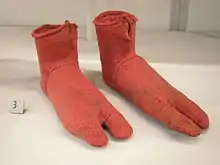
- Saqiyah – Paddle-driven water-lifting wheels had appeared in ancient Egypt by the 4th century BCE.[318] According to John Peter Oleson, both the compartmented wheel and the hydraulic noria appeared in Egypt by the 4th century BCE, with the sakia being invented there a century later. This is supported by archeological finds at Faiyum, where the oldest archeological evidence of a water wheel has been found, in the form of a sakia dating back to the 3rd century BCE. A papyrus dating to the 2nd century BCE also found in Faiyum mentions a water wheel used for irrigation, a 2nd-century BC fresco found at Alexandria depicts a compartmented sakia, and the writings of Callixenus of Rhodes mention the use of a sakia in the Ptolemaic Kingdom during the reign of Ptolemy IV Philopator in the late 3rd century BCE.[319]
- Fifteen centuries before Braille, wood-carving techniques were in use in the Catechical school of Alexandria by blind scholars to read and write.[320][321]
Religion
- Catechesis – The oldest Catechical school in the world is the catechical school of Alexandria.[322]
- Theology – Origen an Egyptian scholar of Alexandria is considered to be the father of Theology.[323][324]
- Monasticism – Another major contribution made by the Copts in Egypt to Christianity was the creation and organization of monasticism. Worldwide Christian monasticism stems, either directly or indirectly, from the Egyptian example. The most prominent figures of the monastic movement were Anthony the Great, Paul of Thebes, Macarius the Great, Shenouda the Archimandrite and Pachomius the Cenobite. By the end of the 5th century, there were hundreds of monasteries, and thousands of cells and caves scattered throughout the Egyptian desert. Since then pilgrims have visited the Egyptian Desert Fathers to emulate their spiritual, disciplined lives. Saint Basil the Great Archbishop of Caesarea Mazaca, and the founder and organiser of the monastic movement in Asia Minor, visited Egypt around 357 AD and his monastic rules are followed by the Eastern Orthodox Churches. Saint Jerome, who translated the Bible into Latin, came to Egypt while en route to Jerusalem around 400 AD and left details of his experiences in his letters. Saint Benedict founded the Benedictine Order in the 6th century on the model of Saint Pachomius, although in a stricter form. Coptic Christians practice male circumcision as a rite of passage.[325]
Islamic Egypt
- Fountain pen – According to Qadi al-Nu'man al-Tamimi (d. 974) in his Kitab al-Majalis wa 'l-musayarat, the Fatimid caliph Al-Mu'izz li-Din Allah in Arab Egypt demanded a pen that would not stain his hands or clothes, and was provided with a pen that held ink in a reservoir, allowing it to be held upside-down without leaking.[326]
- Packaging and labeling – The earliest recorded use of paper for packaging dates back to 1035, when a Persian traveler visiting markets in Cairo, Arab Egypt, noted that vegetables, spices and hardware were wrapped in paper for the customers after they were sold.[327]
- Sugar refinery – Date back to the 12th century in Arab Egypt.[328]
- Torpedo – Torpedo-like weapons were first proposed many centuries before they were successfully developed. For example, in 1275, Arab engineer Hasan al-Rammah from Syria – who worked as a military scientist for the Mamluk Sultanate of Egypt – wrote that it might be possible to create a projectile resembling "an egg", which propelled itself through water, whilst carrying "fire".[329]
- Double-entry bookkeeping – Double-entry bookkeeping was pioneered in the Jewish community of the medieval Middle East.[330][331]
- Abu Kamil was an Egyptian scientist who's considered to be the first mathematician to systematically use and accept irrational numbers as solutions and coefficients to equations.[332]
- Da'irah al-Mu'addal – An astronomical device invented by the Egyptian scientist 'Abd al-'Aziz al-Wafa'i.[333]
Modern Egypt
- Anti-shock rubber car bodies[334]
- Cancer treatment with gold – This discovery was made by the Egyptian scientist Mostafa El-Sayed.[335]
- WiLAN, Wi-Fi, LAN, 3G and 4G – In 1992, Hatim Zaghloul and Michel Fattouche co-founded WiLAN[336] after they developed together the Wideband Orthogonal Frequency Division Multiplexing (WOFDM),[337] and Multi-code Direct-sequence Spread Spectrum (MCDSSS).[338] Through WiLAN's efforts, the Federal Communications Commission (FCC) has allowed OFDM technology over the 2.4 GHz unlicensed ISM band for the Institute of Electrical and Electronics Engineers (IEEE) 802.11 standards. MC-DSSS (MultiCode-Direct-sequence Spread Spectrum) is central to high speed CDMA applications, the main technology currently used by many cellphone networks. The works of Hatim Zaghloul and WiLAN contributed to the invention of Wi-fi, 3G technology and 4G technology.
- Sameera Moussa developed an equation that would allow the atoms of cheap metals (e.g. Copper) to be split and radiate nuclear radiations.[339]
- El Sayed's rule
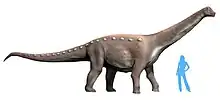
- Femtochemistry – Zewail's key work was an explorer of femtochemistry[340][341][342]—i.e. the study of chemical reactions across femtoseconds. Using a rapid ultrafast laser technique (consisting of ultrashort laser flashes), the technique allows the description of reactions on very short time scales – short enough to analyse transition states in selected chemical reactions.[343] Zewail became known as the "father of femtochemistry".[344]
- Speed-ball – Speed-Ball is a racquet sport invented in Egypt in 1961 by Mohamed Lotfy (grandfather of Taimour Lotfy) for the training of beginner tennis players. Today it is a sport in its own right, enjoying popularity not only in Egypt but in other countries. Several of these countries make up the International Federation of Speed-Ball (FISB).
- Mansourasaurus – Hesham Sallam, a paleontologist at Mansoura University, together with a team of students discovered a sauropod skeleton in the Dakhla Oasis in Egypt's Western Desert.[345] In 2016, it was reported that over thirty dinosaur specimens had been excavated, among them titanosaurian sauropods.[346]
Inventions by MOSFET and Mohamed M. Atalla
The invention of the MOSFET (metal–oxide–semiconductor field-effect transistor, or MOS transistor), by Mohamed M. Atalla and Dawon Kahng at Bell Labs in 1959,[347] enabled the practical use of metal–oxide–semiconductor (MOS) transistors as memory cell storage elements, a function previously served by magnetic cores. MOS memory was developed by John Schmidt at Fairchild Semiconductor in 1964.[348]
The MOSFET forms the basis of modern electronics,[349] and is the basic element in most modern electronic equipment.[350] It is the most common transistor in electronics,[351] and the most widely used semiconductor device in the world.[352] It has been described as the "workhorse of the electronics industry"[353] and "the base technology" of the late 20th to early 21st centuries. MOSFET scaling and miniaturization (see List of semiconductor scale examples) have been the primary factors behind the rapid exponential growth of electronic semiconductor technology since the 1960s,[354] as the rapid miniaturization of MOSFETs has been largely responsible for the increasing transistor density, increasing performance and decreasing power consumption of integrated circuit chips and electronic devices since the 1960s.[355]
- Aluminum gate and Metal gate – A metal gate, in the context of a lateral metal-oxide-semiconductor (MOS) stack, is just that—the gate material is made from a metal. The first MOSFET (metal-oxide-semiconductor field-effect transistor, or MOS transistor) was invented by Egyptian engineer Mohamed Atalla and Korean engineer Dawon Kahng at Bell Labs in 1959, and demonstrated in 1960.[356] They used silicon as channel material and a non-self-aligned aluminium (Al) gate.[357]
- Atalla Box – He invented the first hardware security module (HSM),[358] dubbed the "Atalla Box", a security system which encrypted PIN and ATM messages, and protected offline devices with an un-guessable PIN-generating key.[359] He commercially released the "Atalla Box" in 1973. The success of the "Atalla Box" led to the wide adoption of PIN-based hardware security modules.[360] Its PIN verification process was similar to the later IBM 3624.[361] By 1998 an estimated 70% of all ATM transactions in the United States were routed through specialized Atalla hardware modules,[362] and by 2003 the Atalla Box secured 80% of all ATM machines in the world,[363] increasing to 85% as of 2006.[364] Atalla's HSM products protect 250 million card transactions every day as of 2013,[365] and still secure the majority of the world's ATM transactions as of 2014.[358]
- Atalla Key Block or Block cipher – The root of all cryptographic block formats used within the Payment Card Industry Data Security Standard (PCI DSS) and American National Standards Institute (ANSI) standards lies with the Atalla Key Block (AKB), which was a key innovation of the Atalla Box, the first hardware security module (HSM). It was developed in 1972 by Mohamed M. Atalla, founder of Atalla Corporation (now Utimaco Atalla), and released in 1973. The AKB was a key block, which is required to securely interchange symmetric keys or PINs with other actors of the banking industry. This secure interchange is performed using the AKB format.[366]
- Charge trap flash – The original MOSFET (metal-oxide-semiconductor field-effect transistor, or MOS transistor) was invented by Egyptian engineer Mohamed M. Atalla and Korean engineer Dawon Kahng at Bell Labs in 1959, and demonstrated in 1960.[367] Kahng went on to invent the floating-gate MOSFET with Simon Min Sze at Bell Labs, and they proposed its use as a floating-gate (FG) memory cell, in 1967.[368] This was the first form of non-volatile memory based on the injection and storage of charges in a floating-gate MOSFET,[369] which later became the basis for EPROM (erasable PROM), EEPROM (electrically erasable PROM) and flash memory technologies.[370][371]
- Depletion and enhancement modes – The first MOSFET (metal-oxide-semiconductor field-effect transistor) demonstrated by Egyptian engineer Mohamed M. Atalla and Korean engineer Dawon Kahng at Bell Labs in 1960 was an enhancement mode silicon semiconductor device.[372] In 1963, both depletion and enhancement mode MOSFETs were described by Steve R. Hofstein and Fred P. Heiman at RCA Laboratories.[373]
- Display driver – The use of integrated circuit technology to drive a display driver chip dates back to the late 1960s. Its development was led by Howard C. Borden, Gerald P. Pighini, and Egyptian engineer Mohamed M. Atalla, at HP Associates and HP Labs, who had engaged in research and development (R&D) on practical LEDs between 1962 and 1968.[374]
- FET amplifier and Thermal oxidation – The basic principle of the field-effect transistor (FET) amplifier was first proposed by Austro-Hungarian physicist Julius Edgar Lilienfeld in 1925.[375] However, his early FET concept was not a practical design.[351] The FET concept was later also theorized by Oskar Heil in the 1930s and William Shockley in the 1940s, but there was no working practical FET built at the time. A breakthrough came with the work of Egyptian engineer Mohamed M. Atalla in the late 1950s.[376] He developed the method of surface passivation, which later became critical to the semiconductor industry as it made possible the mass-production of silicon semiconductor technology, such as integrated circuit (IC) chips.[377][351][378] For the surface passivation process, he developed the method of thermal oxidation, which was a breakthrough in silicon semiconductor technology.[379] The surface passivation method was presented by Atalla in 1957.[380]
- Gate dielectric – The earliest gate dielectric used in a field-effect transistor was silicon dioxide (SiO2). The silicon and silicon dioxide surface passivation process was developed by Egyptian engineer Mohamed M. Atalla at Bell Labs during the late 1950s, and then used in the first MOSFETs (metal-oxide-semiconductor field-effect transistors). Silicon dioxide remains the standard gate dielectric in MOSFET technology.[381]
- Gate oxide (With multiple varieties: 20 µm process, 10 nm process, 130 nm process) - The first MOSFET (metal-oxide-semiconductor field-effect transistor, or MOS transistor) was invented by Egyptian engineer Mohamed Atalla and Korean engineer Dawon Kahng at Bell Labs in 1959.[382] In 1960, Atalla and Kahng fabricated the first MOSFET with a gate oxide thickness of 100 nm, along with a gate length of 20 µm.[383] In 1987, Bijan Davari led an IBM research team that demonstrated the first MOSFET with a 10 nm gate oxide thickness, using tungsten-gate technology.[384]
- Internet security – In 1972, Egyptian engineer Mohamed M. Atalla filed U.S. Patent 3,938,091 for a remote PIN verification system, which utilized encryption techniques to assure telephone link security while entering personal ID information, which would be transmitted as encrypted data over telecommunications networks to a remote location for verification. This was a precursor to Internet security and e-commerce.[385] At the National Association of Mutual Savings Banks (NAMSB) conference in January 1976, Atalla Corporation (founded by Mohamed Atalla) and Bunker Ramo Corporation (founded by George Bunker and Simon Ramo) introduced the earliest products designed for dealing with online security. Atalla announced an upgrade to its Identikey hardware security module, called the Interchange Identikey. It added the capabilities of processing online transactions and dealing with network security.
- LED lamp and LED display – The first low-powered LEDs were developed in the early 1960s, and only produced light in the low, red frequencies of the spectrum. In 1968, the first commercial LED lamps were introduced: Hewlett-Packard's LED display,[386] which was developed under Howard C. Borden, Gerald P. Pighini, and Egyptian engineer Mohamed M. Atalla,[374] and Monsanto Company's LED indicator lamp.[386] However, early LED lamps were inefficient and could only display deep red colors, making them unsuitable for general lighting and restricting their usage to numeric displays and indicator lights.
- Microprocessor – The microprocessor has origins in the development of the MOSFET (metal-oxide-semiconductor field-effect transistor, or MOS transistor),[387] which was first demonstrated by Mohamed M. Atalla and Dawon Kahng of Bell Labs in 1960.[388]
- MOS integrated circuit – The MOSFET is the most widely used type of transistor and the most critical device component in integrated circuit (IC) chips.[389] The monolithic integrated circuit chip was enabled by the surface passivation process, which electrically stabilized silicon surfaces via thermal oxidation, making it possible to fabricate monolithic integrated circuit chips using silicon. The surface passivation process was developed by Mohamed M. Atalla at Bell Labs in 1957. This was the basis for the planar process, developed by Jean Hoerni at Fairchild Semiconductor in early 1959, which was critical to the invention of the monolithic integrated circuit chip by Robert Noyce later in 1959.[390][391][392] The same year, Atalla used his surface passivation process to invent the MOSFET with Dawon Kahng at Bell Labs.[377][351] This was followed by the development of clean rooms to reduce contamination to levels never before thought necessary, and coincided with the development of photolithography[393] which, along with surface passivation and the planar process, allowed circuits to be made in few steps.
- MOSFET – In 1955, Carl Frosch and Lincoln Derrick accidentally covered the surface of silicon wafer with a layer of silicon dioxide. They showed that oxide layer prevented certain dopants into the silicon wafer, while allowing for others, thus what they discovered was passivation of semiconductor surface using thermal oxidation. At Shockley Semiconductor, Shockley had circulated the preprint of their article in December 1956 to all his senior stuff, including Jean Hoerni.[394][395] Mohamed M. Atalla at the time was dealing with the problem of surface states. He picked up Frosch's work on oxidation, attempting to passivate the surface of silicon through the formation of oxide layer over it. He thought that growing a very thin high quality thermally grown SiO2 on top of a clean silicon wafer would neutralize surface states enough to make a practical working transistor. He wrote his findings in his BTL memos in 1957, before presenting his work at an Electrochemical Society meeting in 1958. The next year John L. Moll described a MOS diode and coined the name "MOS" in the conference paper on the MOS diode. J.R. Ligenza and W.G. Spitzer, who studied the mechanism of thermally grown oxides, managed to fabricate the first high quality Si/SiO2 stack.[396][351][377][397][398][399][400][401]
- MOS capacitor and Field effect (semiconductor) – The MOS capacitor structure is the heart of the MOSFET. Consider a MOS capacitor where the silicon base is of p-type. If a positive voltage is applied at the gate, holes which are at the surface of the p-type substrate will be repelled by the electric field generated by the voltage applied. At first, the holes will simply be repelled and what will remain on the surface will be immobile (negative) atoms of the acceptor type, which creates a depletion region on the surface. Remember that a hole is created by an acceptor atom, e.g. Boron, which has one less electron than Silicon. One might ask how can holes be repelled if they are actually non-entities? The answer is that what really happens is not that a hole is repelled, but electrons are attracted by the positive field, and fill these holes, creating a depletion region where no charge carriers exist because the electron is now fixed onto the atom and immobile.
- Nanotechnology, Nanocircuitry Nanoelectronics and Molecular scale electronics – In 1960, Egyptian engineer Mohamed Atalla and Korean engineer Dawon Kahng at Bell Labs fabricated the first MOSFET (metal-oxide-semiconductor field-effect transistor) with a gate oxide thickness of 100 nm, along with a gate length of 20 µm.[402] In 1962, Atalla and Kahng fabricated a nanolayer-base metal–semiconductor junction (M–S junction) transistor that used gold (Au) thin films with a thickness of 10 nm.[403]
- NMOS logic and PMOS logic – The MOSFET was invented by Egyptian engineer Mohamed M. Atalla and Korean engineer Dawon Kahng at Bell Labs in 1959, and demonstrated in 1960.[347] They fabricated both PMOS and NMOS devices with a 20 µm process. However, the NMOS devices were impractical, and only the PMOS type were practical devices.[378]
- p–n junction isolation – Before the invention of the integrated circuit, discrete diodes and transistors exhibited relatively high reverse-bias junction leakages and low breakdown voltage, caused by the large density of traps at the surface of single crystal silicon. The solution to this problem was the surface passivation process developed by Egyptian engineer Mohamed Atalla at Bell Telephone Laboratories (BTL). He discovered that when a thin layer of silicon dioxide was grown on the surface of silicon where a p–n junction intercepts the surface, the leakage current of the junction was reduced by a factor from 10 to 100. This showed that the oxide reduces and stabilizes many of the interface and oxide traps. Oxide-passivation of silicon surfaces allowed diodes and transistors to be fabricated with significantly improved device characteristics, while the leakage path along the surface of the silicon was also effectively shut off. This became one of the fundamental isolation capabilities necessary for planar technology and integrated circuits.[404] According to Fairchild Semiconductor engineer Chih-Tang Sah, Atalla's surface passivation method was critical to the development of the silicon integrated circuit.[404][405]
- Planar process – Surface passivation, the process by which a semiconductor surface is rendered inert, and does not change semiconductor properties as a result of interaction with air or other materials in contact with the surface or edge of the crystal, was first developed by Egyptian engineer Mohamed M. Atalla at BTL in the late 1950s.[406][407]
- PIN – Mohamed M. Atalla invented the first PIN-based hardware security module (HSM),[358] dubbed the "Atalla Box", a security system which encrypted PIN and ATM messages, and protected offline devices with an un-guessable PIN-generating key.[359] In 1972, Atalla filed U.S. Patent 3,938,091 for his PIN verification system, which included an encoded card reader and described a system that utilized encryption techniques to assure telephone link security while entering personal ID information that was transmitted to a remote location for verification.[385]
- Secure cryptoprocessor and hardware security module – The hardware security module (HSM), a type of secure cryptoprocessor, was invented by Egyptian-American engineer Mohamed M. Atalla,[358] in 1972.[365]
- Semiconductor device fabrication – The first metal–oxide–silicon field-effect transistors (MOSFETs) were fabricated by Egyptian engineer Mohamed M. Atalla and Korean engineer Dawon Kahng at Bell Labs between 1959 and 1960.[378] There were originally two types of MOSFET technology, PMOS (p-type MOS) and NMOS (n-type MOS).[408] Both types were developed by Atalla and Kahng when they originally invented the MOSFET, fabricating both PMOS and NMOS devices at 20 µm and 10 µm scales.[357]
- Silicon wafer – In the 1950s, Mohamed Atalla investigated the surface properties of silicon semiconductors at Bell Labs, where he adopted a new method of semiconductor device fabrication, coating a silicon wafer with an insulating layer of silicon oxide, so that electricity could reliably penetrate to the conducting silicon below, overcoming the surface states that prevented electricity from reaching the semiconducting layer. This is known as surface passivation, a method that later became critical to the semiconductor industry as it made possible the mass-production of silicon integrated circuits (ICs).[409][410][378] The surface passivation method was presented by Atalla in 1957,[380] and was later the basis for the metal-oxide-semiconductor (MOS) process invented by Atalla and Dawon Kahng in 1959.
- Telephone banking – In 1972, Egyptian engineer Mohamed M. Atalla, the founder of Atalla Corporation, filed U.S. Patent 3,938,091 for a remote personal verification system which utilized encryption techniques to assure telephone link security while entering personal ID information, which would be transmitted as encrypted data over telecommunications networks to a remote location for verification. This was a precursor to telephone banking.[385] The patent mentioned the system's application for the use of a credit card over a telephone call.[411]
- His invention of the MOSFET was initially overlooked at Bell, which led to him resigning from Bell and joining Hewlett-Packard (HP), founding its Semiconductor Lab in 1962 and then HP Labs in 1966, before leaving to join Fairchild Semiconductor, founding its Microwave & Optoelectronics division in 1969. His work at HP and Fairchild included research on Schottky diode, gallium arsenide (GaAs), gallium arsenide phosphide (GaAsP), indium arsenide (InAs) and light-emitting diode (LED) technologies.[412]
Notes
- Allegedly built so that the circle whose radius is equal to the height of the pyramid has a circumference equal to the perimeter of the base
- "Smy, or thickened milk, both human and animal, is often mentioned in medical prescriptions."[242]
References
- "Kilidavid".
- Keeley, Lawrence H: War Before Civilization: The Myth of the Peaceful Savage. p. 37.
- Diamond, Jared, Guns, Germs and Steel
- Darvill, T: The Concise Oxford Dictionary of Archaeology, Copyright 2002, 2003 by Oxford University Press.
- "Ancient Egyptian Culture". Archived from the original on 2010-06-01.
- "Wendorf, Fred; Schild, Romuald (November 26, 2000), Late Neolithic megalithic structures at Nabta Playa (Sahara), southwestern Egypt". Archived from the original on 2011-08-06.
- "Brophy, TG; Rosen PA (2005). "Satellite Imagery Measures of the Astronomically Aligned Megaliths at Nabta Playa" (PDF)" (PDF). Archived from the original (PDF) on 2008-02-29.
- Malville, J. McKim (2015), "Astronomy at Nabta Playa, Egypt", in Ruggles, C.L.N. (ed.), Handbook of Archaeoastronomy and Ethnoastronomy, 2, New York: Springer Science+Business Media, pp. 1079–1091, ISBN 978-1-4614-6140-1
- Kahl 2007, p. 13.
- Grimal, Nicolas-Christophe. (January 1992). A history of ancient Egypt. Shaw, Ian, 1961–. Oxford, UK: 256–257. ISBN 0-631-17472-9. OCLC 25410477.
- Joshua J. Mark (4 November 2016). "Women in Ancient Egypt". Ancient History Encyclopedia. Retrieved 26 July 2017.
- Théodoridés. "law". Encyclopedia of the Archaeology of Ancient Egypt.
- VerSteeg, Law in ancient Egypt
- Lippert, Sandra (11 February 2016). "Egyptian Law, Saite to Roman Periods". Oxford Handbooks Online. Oxford University Press. doi:10.1093/oxfordhb/9780199935390.013.48. Retrieved 3 January 2020.
- Flag | heraldry. Encyclopædia Britannica. Retrieved February 15, 2019.
- François Daumas, (1969). Ägyptische Kultur im Zeitalter der Pharaonen, pp. 309. Knaur Verlag, Munich
- John Romer, Ancient Lives; the story of the Pharaoh's Tombmakers. London: Phoenix Press, 1984, pp. 116–123 See also E.F. Wente, "A letter of complaint to the Vizier To", in Journal of Near Eastern Studies, 20, 1961 and W.F. Edgerton, "The strikes in Ramses III's Twenty-ninth year", Journal of Near Eastern Studies, 10, 1951.
- Peter Kaplony: „Er ist ein Liebling der Frauen“ – Ein „neuer“ König und eine neue Theorie zu den Kronprinzen sowie zu den Staatsgöttinnen (Kronengöttinnen) der 1./2. Dynastie. In: Manfred Bietak: Ägypten und Levante. Verlag der Österreichischen Akademie der Wissenschaften, Wien 2006 ISBN 978-3-7001-6668-9; page 126–127.
- Dietrich Wildung: Die Rolle ägyptischer Könige im Bewußtsein ihrer Nachwelt. page 36–41.
- Wolfgang Helck: Untersuchungen zur Thinitenzeit. (Ägyptologische Abhandlungen, Vol. 45). Harrassowitz, Wiesbaden 1987, ISBN 3-447-02677-4; page 117
- P.E. Newberry, The Seth rebellion of the 2nd Dynasty, in Ancient Egypt., no. 7. 1922. pp. 40–46.
- Minsky, Hyman P. (March–April 1993). "Community development banks: An idea in search of substance". Challenge. 36 (2): 33–41. doi:10.1080/05775132.1993.11471653.
- Gascoigne, Bamber. "Historyworld". History of Banking. Retrieved March 1, 2014.
- Conser, James A.; Russell, Gregory D.; Gingerich, Terry E.; Paynich, Rebecca (2005). Law Enforcement in the United States. Jones & Bartlett Learning. ISBN 978-0-7637-8352-5.
- "Police in Ancient Egypt". Ancient History Encyclopedia. Retrieved 2020-05-03.
- Universal Postal Union. "History". Accessed 2 October 2013.
- Shaw, Ian (2000). The Oxford history of ancient Egypt. Oxford University Press. ISBN 0-19-280458-8.
- Darnell, John Colemen; Menassa, Colleen. Tutankhamun's Armies. John Wiley and Sons Inc., New Jersey: 2007. p.60
- Trevor N. Dupuy, Evolution of Weapons and Warfare.
- de Microschedji 2008, pp. 2028–2029.
- Lewis, Leo Richard; Tenney, Charles R. (2010). The Compendium of Weapons, Armor & Castles. Nabu Press. p. 139. ISBN 978-1146066846.
- "7.10 Egyptian Forts in Nubia and Indigenous Peoples There". worldhistory.biz. 8 May 2015. Retrieved 23 September 2018.
- "Siege warfare in ancient Egypt". Tour Egypt. Archived from the original on 11 February 2019. Retrieved 23 May 2020.
- "Siege warfare in ancient Egypt". Tour Egypt. Archived from the original on 11 February 2019. Retrieved 23 May 2020.
...we find a pair of Middle Kingdom soldiers advancing towards a fortress under the protection of a mobile roofed structure. They carry a long pole that was perhaps an early battering ram.
- Ian Shaw (17 December 2019). Ancient Egyptian Warfare: Tactics, Weaponry and Ideology of the Pharaohs. ISBN 978-1-5040-6059-2.
- "Britannica: Ram".
- Iorwerth Eiddon Stephen Edwards, Cyril John Gadd, Nicholas Geoffrey Lemprière Hammond, 1970
- The Schoyen Collection: MS 2429/4
- "Dogs of War in European Conflict; Egyptians and Romans Employed Them in Early Warfare – Battle Dogs in 4000 B.C". The New York Times. February 21, 1915. p. S3. Retrieved 2008-11-26.
- "History of Cryptography". Binance Academy. Retrieved 2020-04-02.
- Michael Allan Hoffman: Egypt before the pharaohs: The prehistoric foundations of Egyptian Civilization. Routledge and Kegan Paul, London 1980, ISBN 0-7100-0495-8, p. 312–326.
- Jochem Kahl: "Ober- und Unterägypten: Eine dualistische Konstruktion und ihre Anfänge". In: Rainer Albertz (Hrsg.): Räume und Grenzen: Topologische Konzepte in den antiken Kulturen des östlichen Mittelmeerraums. Utz, München 2007, ISBN 3-8316-0699-4, p. 16.
- Herodotus, The Histories (Vol II), § 99
- Günther Garbrecht: "Wasserspeicher (Talsperren) in der Antike", Antike Welt, 2nd special edition: Antiker Wasserbau (1986), pp.51–64 (52f.)
- Örjan Wikander (2008). "Chapter 6: Sources of Energy and Exploitation of Power". In John Peter Oleson (ed.). The Oxford Handbook of Engineering and Technology in the Classical World. Oxford University Press. pp. 141–2. ISBN 978-0-19-518731-1.
- Crane, Eva (1984). Mason, I. L. (ed.). Honeybees. Evolution of Domesticated Animals. Longman. pp. 403–415.
- Bodenheimer, F. S. (1960). Animal and Man in Bible Lands. Brill Archive. p. 79.
- Mertz, Barbara (1978). Red Land, Black Land: Daily Life in Ancient Egypt. Dodd Mead.
- World's First Zoo – Hierakonpolis, Egypt, Archaeology Magazine, http://www.archaeology.org/1001/topten/egypt.html
- Kapellakis, Iosif Emmanouil (2008). "Olive oil history, production and by-product management". Reviews in Environmental Science Biotechology. 7: 1–26. doi:10.1007/s11157-007-9120-9. S2CID 84992505.
- To Elaiodentro. (Olive Tree), vol I
- "10 Amazing Ancient Egyptian Inventions".
- Ward, Cheryl. "World's Oldest Planked Boats," in Archaeology (Volume 54, Number 3, May/June 2001). Archaeological Institute of America. Archaeology.org
- Encyclopedia Of International Sports Studies. Page 31
- Vinson, Steve. 1994. Egyptian boats and ships. Osprey Publishing.
- William F. Edgerton: "Ancient Egyptian Steering Gear", The American Journal of Semitic Languages and Literatures, Vol. 43, No. 4. (1927), pp. 255
- William F. Edgerton: "Ancient Egyptian Steering Gear", The American Journal of Semitic Languages and Literatures, Vol. 43, No. 4. (1927), pp. 257
- William F. Edgerton: "Ancient Egyptian Steering Gear", The American Journal of Semitic Languages and Literatures, Vol. 43, No. 4. (1927), pp. 260
- "World's Oldest Paved Road Found in Egypt – The New York Times". nytimes.com. Retrieved 2018-08-29.
- "Egypt's Widan Al-Faras:The world's oldest road all but forgotten".
- "Lake Meoris Quarry Road".
- Giuliani G, Chaussidon M, Schubnel HJ, Piat DH, Rollion-Bard C, France-Lanord C, Giard D, de Narvaez D, Rondeau B (2000). "Oxygen Isotopes and Emerald Trade Routes Since Antiquity" (PDF). Science. 287 (5453): 631–3. Bibcode:2000Sci...287..631G. doi:10.1126/science.287.5453.631. PMID 10649992. Archived (PDF) from the original on August 7, 2011.
- Weeks 1968, p. 31.
- Weeks 1968, p. 29.
- "Mercury and the environment – Basic facts". Environment Canada, Federal Government of Canada. 2004. Archived from the original on 2007-01-15. Retrieved 2008-03-27.
- "Egyptian civilization – Religion – Mummification".
- "The Chemistry of Mummification".
- "History of Turquoise, from Egypt to Native Americans".
- Nicholson, Paul T.; Shaw, Ian; Press, Cambridge University (2000-03-23). Ancient Egyptian Materials and Technology. Cambridge University Press. ISBN 978-0-521-45257-1.
- http://citeseerx.ist.psu.edu/viewdoc/download?doi=10.1.1.843.619&rep=rep1&type=pdf
- Lucas, A (2003). Ancient Egyptian Materials and Industries. USA: Kessinger Publishing, LLC. p. 584. ISBN 0-7661-5141-7.
- Augosto Castellani (famous Italian 19th century jeweler) (1871), Gems, Notes and Extracts, p. 34, London, Bell and Daldy, ISBN 1-141-06174-0.
- Shaw, I. (2000). The Oxford History of Ancient Egypt. New York: Oxford University Press, pp. 57–59.
- Baker 2008, pp. 343–345.
- Wicker 1998, p. 155.
- Sutherland, C.H.V, Gold (London, Thames & Hudson, 1959) p 27 ff.
- "The History of Lead – Part 3". Lead.org.au. Archived from the original on 2004-10-18. Retrieved 2008-09-12.
- Wilkins, Robert H. (1992). Neurosurgical Classics (2nd ed.). Park Ridge, Illinois: American Association of Neurological Surgeons. ISBN 978-1-879284-09-8.
- Zimmerman, Leo M. Veith, Ilza (1993). Great Ideas in the History of Surgery. San Francisco: Jeremy Norman Publishing. ISBN 978-0-930405-53-3.CS1 maint: multiple names: authors list (link)
- Becker H, Stenzl A, Wallwiener D, Zittel TT (2005). Urinary and fecal incontinence : an interdisciplinary approach; with 89 tables. Berlin [u.a.]: Springer. p. 232. ISBN 978-3540222255.
- Porter, R. (1997). The Greatest Benefit to Mankind: A Medical History of Humanity from Antiquity to the Present. Harper Collins. pp. 49–50. ISBN 978-0-00-215173-3.
- "Science Direct: Cardio-vascular system in Ancient Egypt".
- "Cataract Surgery In Ancient Egypt: Journal of Cataract and Refractive Surgery".
- Hajdu SI (March 2011). "A note from history: landmarks in history of cancer, part 1". Cancer. 117 (5): 1097–102. doi:10.1002/cncr.25553. PMID 20960499. S2CID 39667103.
- Ripoll, Brian C. Leutholtz, Ignacio (2011-04-25). Exercise and disease management (2nd ed.). Boca Raton: CRC Press. p. 25. ISBN 978-1-4398-2759-8. Archived from the original on 2016-04-03.
- Roberts, Jacob (2015). "Sickening sweet". Distillations. Vol. 1 no. 4. pp. 12–15. Retrieved 20 March 2018.
- Poretsky, Leonid, ed. (2009). Principles of diabetes mellitus (2nd ed.). New York: Springer. p. 3. ISBN 978-0-387-09840-1. Archived from the original on 2016-04-04.
- Palmer, Philip E.S.; Reeder, Maurice M. (2008) [First published 1981]. "Chapter 27: Guinea Worm Infection (Dracunculiasis)". The Imaging of Tropical Diseases: With Epidemiological, Pathological and Clinical Correlation (DVD ed.). Uniformed Services University of the Health Sciences. LCCN 99039417.
- Micale, Mark S. (January 15, 2019). Approaching Hysteria: Disease and Its Interpretations. Princeton University Press. ISBN 978-0-691-60561-6.
- Ziskind, B. (2009). "Urinary Schistosomiasis in Ancient Egypt". Nephrologie & Therapeutique. 5 (7): 658–61. doi:10.1016/j.nephro.2009.06.001. PMID 19617021.
- "9 Bizzare Baldness Cures – HISTORY".
- Banov, L., Jr. (December 1965). "The Chester Beatty Medical Papyrus: the earliest known treatise completely devoted to anorectal diseases". Surgery. 58 (6): 1037–1043. PMID 5322341. From the title (text not accessed).
- Ritner, Robert K. (2005). The Oxford Encyclopedia of Ancient Egypt (Online ed.) "Medicine". In Redford, Donald B. (ed.). Oxford Reference. ISBN 978-0-19-518765-6.
- Shah, J. B. (2012). "The History of Wound Care". The Journal of the American College of Certified Wound Specialists. 3 (3): 65–66. doi:10.1016/j.jcws.2012.04.002. PMC 3601883. PMID 24525756.
- "No. 1705: A 3000-Year-Old Toe". Uh.edu. 2004-08-01. Retrieved 2013-03-13.
- El-Aref, Nevine (December 2006). "Too big for a coffin". Al-Ahram Weekly. Cairo, Egypt: Al-Ahram. Archived from the original on 18 November 2014. Retrieved 1 January 2016.
- Hawass, Zahi (2003). "The tomb of the physician Qar". Hidden Treasures of the Egyptian Museum: One Hundred Masterpieces from the Centennial Exhibition (Supreme Council of Antiquities ed.). Cairo, Egypt: American University in Cairo Press. p. xx. ISBN 978-977424778-1.
- Lauer, Jean Philippe (3 January 2013). "Imhoteb Museum". Egypt Tourism News. Egypt Tourism Board. Retrieved 1 January 2016.
- Jackson, Russell (6 December 2006). "Mummy of ancient doctor comes to light". The Scotsman. Edinburgh. Retrieved 2011-03-24.
- "Egyptian Medicine".
- "From Eggshells to NASA – The Fascinating History of Toothpaste".
- "10 Amazing Ancient Egyptian Inventions".
- Laurinda S. Dixon. Perilous Chastity: Women and Illness in Pre-Enlightenment Art and Medicine, Cornell University Press 1995, pp.15f.
- Ghalioungui, P.; Khalil, SH.; Ammar, A. R. (July 1963). "On an Ancient Egyptian Method of Diagnosing Pregnancy and Determining Foetal Sex". Medical History. 7 (3): 241–6. doi:10.1017/s0025727300028386. ISSN 0025-7273. PMC 1034829. PMID 13960613.
- Cuomo, Amy (2010). "Birth control". In O'Reilly, Andrea (ed.). Encyclopedia of motherhood. Thousand Oaks, CA: Sage Publications. pp. 121–26. ISBN 978-1-4129-6846-1.
- Lipsey, Richard G.; Carlaw, Kenneth; Bekar, Clifford (2005). "Historical Record on the Control of Family Size". Economic Transformations: General Purpose Technologies and Long-Term Economic Growth. Oxford University Press. pp. 335–40. ISBN 978-0-19-928564-8.
- Shiffman, Melvin (2012-09-05). Cosmetic Surgery: Art and Techniques. Springer. p. 20. ISBN 978-3-642-21837-8.
- Mazzola, Ricardo F.; Mazzola, Isabella C. (2012-09-05). "History of reconstructive and aesthetic surgery". In Neligan, Peter C.; Gurtner, Geoffrey C. (eds.). Plastic Surgery: Principles. Elsevier Health Sciences. pp. 11–12. ISBN 978-1-4557-1052-2.
- Suture manual (PDF). p. 4.
- "History of Ophthalmology". www.mrcophth.com.
- Imhausen, Annette (2006). "Ancient Egyptian Mathematics: New Perspectives on Old Sources". The Mathematical Intelligencer. 28 (1): 19–27. doi:10.1007/bf02986998. S2CID 122060653.
- Burton, David (2005). The History of Mathematics: An Introduction. McGraw–Hill. ISBN 978-0-07-305189-5.
- Rudman, Peter Strom (2007), How Mathematics Happened: The First 50,000 Years, Prometheus Books, pp. 135–136, ISBN 9781615921768.
- Chrisomalis, Stephen (2010), Numerical Notation: A Comparative History, Cambridge University Press, pp. 42–43, ISBN 9780521878180.
- Eves, Howard (1990). An introduction to the history of mathematics (6th ed.). Philadelphia: Saunders College Pub. ISBN 978-0-03-029558-4.
- Milo Gardner (December 19, 2005). "Math History". Archived from the original on December 19, 2005. Retrieved 2006-01-18. See for examples and an explanation.
- Curtis, Lorenzo J. (1978), "Concept of the exponential law prior to 1900", American Journal of Physics, 46 (9): 896–906, doi:10.1119/1.11512.
- Moore, Deborah Lela (1994). The African roots of mathematics (2nd ed.). Detroit, Mich.: Professional Educational Services. ISBN 1884123007.
- "Egyptian Multiplication".
- Jean-Luc Chabert, ed., A History of Algorithms: From the Pebble to the Microchip (Berlin: Springer, 1999), pp. 86–91.
- Anglin, W.S. (1994). Mathematics: A Concise History and Philosophy. New York: Springer-Verlag.
- Joseph, George Gheverghese (2011). The Crest of the Peacock: Non-European Roots of Mathematics (Third ed.). Princeton UP. p. 86. ISBN 978-0-691-13526-7.
- Karpinski, Louis C. (1917). "Algebraical Developments Among the Egyptians and Babylonians". The American Mathematical Monthly. 24 (6): 257–265. doi:10.2307/2973180. JSTOR 2973180. MR 1518824.
- Petrie, W.M.F. Wisdom of the Egyptians (1940)
- Verner, Miroslav. The Pyramids: The Mystery, Culture, and Science of Egypt's Great Monuments. Grove Press. 2001 (1997). ISBN 0-8021-3935-3
- "Phi, Pi and the Great Pyramid of Giza".
- Chace, Arnold Buffum (1979) [1927–29]. The Rhind Mathematical Papyrus: Free Translation and Commentary with Selected Photographs, Translations, Transliterations and Literal Translations. Classics in Mathematics Education. 8. 2 vols (Reston: National Council of Teachers of Mathematics Reprinted ed.). Oberlin: Mathematical Association of America. ISBN 0-87353-133-7.
- Clagett, Marshall (1999). Ancient Egyptian Science: A Source Book. Volume 3: Ancient Egyptian Mathematics. Memoirs of the American Philosophical Society. Philadelphia: American Philosophical Society. p. 232. ISBN 0-87169-232-5.
- Gillings: Mathematics in the Time of the Pharaohs 1982: pp 212
- Gillings: Mathematics in the Time of the Pharaohs 1982: pp 212
- Maor, Eli (1998). Trigonometric Delights. Princeton University Press. p. 20. ISBN 978-0-691-09541-7.
- Gillings, Richard J. (1982). Mathematics in the Time of the Pharaohs. Dover Publications. ISBN 9780486243153. OCLC 301431218.
- Clagett, Marshall (1989). Ancient Egyptian Science: Ancient Egyptian mathematics. American Philosophical Society. ISBN 9780871692320. OCLC 313400062.
- Williams, Scott W. Egyptian Mathematical Papyri
- "Egyptian Mathematics - Numbers and Numerals".
- Clagett, Marshall. 1999. Ancient Egyptian Science: A Source Book. Volume 3: Ancient Egyptian Mathematics. Memoirs of the American Philosophical Society 232. Philadelphia: American Philosophical Society. ISBN 0-87169-232-5
- "History of Metrology". Measurement Science Conference. Archived from the original on 1 March 2017. Retrieved 28 February 2017.
- Englebach, Clarke (1990). Ancient Egyptian Construction and Architecture. New York: Dover. ISBN 0486264858.
- Clagett, Marshall (1999), Ancient Egyptian Science: A Source Book, Vol. III: Ancient Egyptian Mathematics, Memoirs of the APS, Vol. 232, Philadelphia: American Philosophical Society, ISBN 978-0-87169-232-0.
- Gillings, Richard (1972). Mathematics in the Time of the Pharaohs. MIT. ISBN 0262070456.
- Johnson, Paul (1999). The Civilization Of Ancient Egypt. HarperCollins. pp. 113. ISBN 978-0-06-019434-5.
- Harrell, James A. "Turin Papyrus Map from Ancient Egypt", Research on the Archaeological Geology of Ancient Egypt, Accessed Feb 24, 2018, http://www.eeescience.utoledo.edu/Faculty/Harrell/Egypt/Turin%20Papyrus/Harrell_Papyrus_Map_text.htm.
- McMahon, David M., "The Turin Papyrus Map The Oldest Known Map with Geological Significance", Earth Sciences History 11 no. 1 (1992): 9–12.
- Carmeni, U., "La Mappa delle Miniere del Museo Egizio di Torino. Come entrare nel suo spazio e come interpretarlo", conference edited by A.C.M.E., Torino, 2013
- Symons, S. L., Cockcroft, R., Bettencourt, J. and Koykka, C. (2013). Ancient Egyptian Astronomy [Online database] Diagonal Star Tables
- Porceddu, S.; Jetsu, L.; Lyytinen, J.; Kajatkari, P.; Lehtinen, J.; Markkanen, T.; et al. (2008). "Evidence of Periodicity in Ancient Egyptian Calendars of Lucky and Unlucky Days". Cambridge Archaeological Journal. 18 (3): 327–339. Bibcode:2008CArcJ..18..327P. doi:10.1017/S0959774308000395.
- Jetsu, L.; Porceddu, S.; Lyytinen, J.; Kajatkari, P.; Lehtinen, J.; Markkanen, T.; et al. (2013). "Did the Ancient Egyptians Record the Period of the Eclipsing Binary Algol – The Raging One?". The Astrophysical Journal. 773 (1): A1 (14pp). arXiv:1204.6206. Bibcode:2013ApJ...773....1J. doi:10.1088/0004-637X/773/1/1. S2CID 119191453.
- Jetsu, L.; Porceddu, S. (2015). "Shifting Milestones of Natural Sciences: The Ancient Egyptian Discovery of Algol's Period Confirmed". PLOS ONE. 10 (12): e.0144140 (23pp). arXiv:1601.06990. Bibcode:2015PLoSO..1044140J. doi:10.1371/journal.pone.0144140. PMC 4683080. PMID 26679699.
- Clagett (1995), p. 28.
- "Ancient Egyptian Star Clocks and Their Theory".
- "Who Discovered The Solstice First".
- The oldest surviving sundial
- Jacques W. Delleur (12 December 2010). The Handbook of Groundwater Engineering, Second Edition. Taylor & Francis. p. 7 in chapter 2. ISBN 978-0-8493-4316-2.
- Boyle, Alan (15 April 2013). "4,500-year-old harbor structures and papyrus texts unearthed in Egypt". NBC.
- Marouard, Gregory; Tallet, Pierre (2012). "Wadi al-Jarf – An early pharaonic harbour on the Red Sea coast". Egyptian Archaeology. 40: 40–43. Retrieved 18 April 2013.
- Tallet, Pierre (2012). "Ayn Sukhna and Wadi el-Jarf: Two newly discovered pharaonic harbours on the Suez Gulf" (PDF). British Museum Studies in Ancient Egypt and Sudan. 18: 147–68. ISSN 2049-5021. Retrieved 21 April 2013.
- Herodotus, Robin Waterfield, and Carolyn Dewald. The Histories. Oxford: Oxford UP, 2008. Print.
- Clarke, Somers; Engelbach, Reginald (1990). Ancient Egyptian Construction and Architecture. Courier Corporation. pp. 86–90. ISBN 9780486264851.
- Bruno, Leonard C.; Olendorf, Donna (1997). Science and technology firsts. Gale Research. p. 2. ISBN 9780787602567.
4400 B.C. Earliest evidence of the use of a horizontal loom is its depiction on a pottery dish found in Egypt and dated to this time. These first true frame looms are equipped with foot pedals to lift the warp threads, leaving the weaver's hands free to pass and beat the weft thread.
- Houston, Keith, The Book: A Cover-to-Cover Exploration of the Most Powerful Object of our Time, W. W. Norton & Company, 2016, pp.4–8 excerpt
- Tallet, Pierre (2012). "Ayn Sukhna and Wadi el-Jarf: Two newly discovered pharaonic harbours on the Suez Gulf" (PDF). British Museum Studies in Ancient Egypt and Sudan. 18: 147–68. ISSN 2049-5021. Retrieved 21 April 2013.
- H. Idris Bell and T.C. Skeat, 1935. "Papyrus and its uses" (British Museum pamphlet). Archived 18 October 2013 at the Wayback Machine
- Stille, Alexander. "The World's Oldest Papyrus and What It Can Tell Us About the Great Pyramids". Retrieved 2015-09-27.
- Arnold, Dieter (1991). Building in Egypt: Pharaonic Stone Masonry. Oxford University Press. p. 71. ISBN 9780195113747.
- Robillard, Walter G.; Wilson, Donald A.; Brown, Curtis M.; Eldridge, Winfield (31 January 2011). Evidence and Procedures for Boundary Location. p. 282. ISBN 9780470901601.
- Williams, Kim; Ostwald, Michael J. (9 February 2015). Architecture and Mathematics from Antiquity to the Future: Volume I: Antiquity to the 1500s. p. 98. ISBN 9783319001371.
- Denys A. Stocks. Experiments in Egyptian archaeology: stoneworking technology in ancient Egypt. Routledge; 2003. ISBN 978-0-415-30664-5. p. 180.
- Battiscombe Gunn (1926). "AN ARCHITECT'S DIAGRAM OF THE 3RD DYNASTY". Retrieved 30 April 2016.
- http://www.moundtop.com/pdf/AncientWinemaking.pdf
- Usher, Abbott Payson (15 April 2018). A History of Mechanical Inventions. Courier Corporation. ISBN 978-0-4862-5593-4. Retrieved 15 April 2018 – via Google Books.
- One of world's oldest sundials dug up in Kings' Valley, Upper Egypt
- Major, p. 9
- "Sundial". Encyclopædia Britannica. Retrieved April 4, 2008.
- Bruton, Eric (1979). The History of Clocks and Watches (1982 ed.). New York: Crescent Books. ISBN 0-517-37744-6.
- Cotterell, Brian; Kamminga, Johan (1990). Mechanics of pre-industrial technology: An introduction to the mechanics of ancient and traditional material culture. Cambridge University Press. ISBN 0-521-42871-8. OCLC 18520966., pp. 59–61
- Cotterell & Kamminga 1990, pp. 59–61
- Berlev, Oleg (1997). "Bureaucrats". In Donadoni, Sergio (ed.). The Egyptians. Trans. Bianchi, Robert et al. Chicago: The University of Chicago Press. p. 118. ISBN 0-226-15555-2.
- Wallenfels, Ronald (2000). The Ancient Near East: An Encyclopedia for Students, Volume 2. Scribner. p. 145. ISBN 9780684805948.
- Fletcher, Joann; Salamone, Filippo (2016). "An Ancient Egyptian Wig: Construction and Reconstruction". Internet Archaeology (42). doi:10.11141/ia.42.6.3.
- Thomas, Burke (2005). "Transport and the Inclined Plane". Construction of the Giza Pyramids. world-mysteries.com. Retrieved March 10, 2012.
- Isler, Martin (2001). Sticks, stones, and shadows: building the Egyptian pyramids. USA: University of Oklahoma Press. pp. 211–216. ISBN 978-0-8061-3342-3.
- Sprague de Camp, L. (1990). The Ancient Engineers. USA: Barnes & Noble. p. 43. ISBN 978-0-88029-456-0.
- David Diringer, The Book before Printing: Ancient, Medieval and Oriental, Dover Publications, New York 1982, p. 172.
- "10 Amazing Ancient Egyptian Inventions".
- "Ancient Egyptian Inventions".
- John Gardiner Wilkinson (1837). The Manners and Customs of the Ancient Egyptians / Volume 3. p. 338.
- "Who invented air conditioning".
- "A Brief History of Hand Fan".
- Egyptian reed pen Archived 2007-02-21 at the Wayback Machine Retrieved March 16, 2007.
- "Spoon." Encyclopædia Britannica Eleventh Edition, 1911. Viewing the linked scan requires the AlternaTiff plugin in most browsers. This article incorporates text from this source, which is now in the public domain.
- "History of Chopsticks, Forks, Spoon and Sporks – Who Invented The Spoon? – Who Invented The Forks?".
- "Who Invented The Scissors".
- "The History of Scissors".
- "Egyptians May Have Invented The World's First Protractor".
- Bunson, Margaret (2014-05-14). Encyclopedia of Ancient Egypt. Infobase Publishing. p. 6. ISBN 978-1-4381-0997-8.
- New Standard Encyclopedia. Standard Educational Corp. 1978. p. A-257. ISBN 9780873921831. Retrieved 30 April 2020.
The Archimedes' screw was developed in ancient Egypt and was subsequently used by Archimedes (287–212 b.c.)
- "Screw". Encyclopædia Britannica online. The Encyclopaedia Britannica Co. 2011. Retrieved 2011-03-24.
- Stewart, Bobby Alton; Terry A. Howell (2003). Encyclopedia of water science. USA: CRC Press. p. 759. ISBN 0-8247-0948-9.
- Metropolitan Museum of Art Staff (1999). Egyptian Art in the Age of the Pyramids. Metropolitan Museum of Art. p. 117. ISBN 9780870999079.
- https://study.com/academy/lesson/ancient-egyptian-furniture-history-design.html
- Extraordinary Origins of Everyday Things. Reader's Digest. 27 November 2009. p. 13. ISBN 978-0276445699.
- "Furniture". Ancient Egyptian Furniture. Archived from the original on 21 October 2008. Retrieved 13 May 2012.
- Blakemore 2006, p. 22.
- Blakemore 2006, p. 24.
- Toby Wilkinson, The Thames and Hudson Dictionary of Ancient Egypt, Thames & Hudson, 2005. p.195
- "NOVA Online | Mysteries of the Nile | A World of Obelisks: Cairo". Pbs.org. Retrieved 14 June 2013.
- Griffith, Francis Llewellyn (1911). . In Chisholm, Hugh (ed.). Encyclopædia Britannica. 19 (11th ed.). Cambridge University Press. p. 945.
- Descroches-Noblecourt, L’Art Egyptien, pg. 113
- Brier, Bob, Hobbs, A. Hoyt, Daily Life of the Ancient Egyptians, p. 200, 2008, Greenwood Publishing Group, ISBN 0313353069, 9780313353062, google books
- Alessandro Bongioanni & Maria Croce (ed.), The Treasures of Ancient Egypt: From the Egyptian Museum in Cairo, Universe Publishing, a division of Ruzzoli Publications Inc., 2003. p. 310
- Chase, W.T. 1971, "Egyptian blue as a pigment and ceramic material." In: R. Brill (ed.) Science and Archaeology. Cambridge, Mass: MIT Press. ISBN 0-262-02061-0
- Wilkinson, John Gardner (1847) [1837]. "5". Manners and Customs of the Ancient Egyptians, including Their Private Life, Government, Laws, Art, Manufactures, Religion, Agriculture, and Early History. II (3rd ed.). London: John Murray. p. 334.
- Hart (2005), p. 65
- Origin of the clarinet, the-clarinets.net
- George Kyrillos. Russian Orthodox Encyclopedia vol.37 – The Musicality of Coptic Hymns (PDF). p. 5.
- George Kyrillos. Russian Orthodox Encyclopedia vol.37 – The Musicality of Coptic Hymns (PDF). p. 13.
- Allen, James P. (2003). The Ancient Egyptian Language. Cambridge University Press. p. 2. ISBN 978-1-107-66467-8.
- Edward F. Wente (1990). Letters from Ancient Egypt: Society of Biblical Literature Writing from the Ancient World Series Volume 1. Translated by Edmund S. Meltzer. Atlanta, GA: Scholars Press. hdl:2027/heb.02262.0001.001. ISBN 978-1555404734.
- Fontaine, Carole R. (1981). "A Modern Look at Ancient Wisdom: The Instruction of Ptahhotep Revisited". The Biblical Archaeologist. 44 (3): 155–160. doi:10.2307/3209606. JSTOR 3209606. S2CID 59261427.
- Petrie, William Matthew; Quibell, James Edward (1896). "VII. Games". Naqada and Ballas, 1895. London: B. Quaritch. p. 35. Cornell University Library. (archeologist's drawing)
- "Bowling History – Origin of Bowling". Retrieved 24 January 2016.
- Luna, Richard (2 June 1984). "Bruce Pluckhahn says there's a little bit of bowling..." United Press International. Archived from the original on 17 April 2019. Statement by Bowling Museum curator Bruce Pluckhahn.
- Kaplan, Jim (April 7, 1986). "Here's a Memory Lane for Bowling Fanatics Who Have Some Spare Time". Sports Illustrated. Archived from the original on 8 May 2019.
- Pretsell, James M. (1908). The Game of Bowls Past and Present. Oliver & Boyd. p. 1.
- "Ancient Egyptian Sport – SIS".
- "Egyptian Olympic Committee".
- "Ancient Egyptian Sports: Rhythmic Gymnastics".
- "Ancient Egyptian Sports : Consecutive Vault".
- "Ancient Egyptian Sports : Gymnastics".
- "Ancient Egyptian Sports : Weightlifting".
- "Ancient Egyptian Sports : Tug of War".
- "Ancient Egyptian Sports : Tug of Hoop".
- "Ancient Egyptian Sports : Equilibrium".
- Maxwell R. Garret, Emmanuil G. Kaidanov, Gil A. Pezza – – Foil, Saber, and Épée Fencing: Skills, Safety, Operations, and Responsibilities Penn State Press 1994 (revised, annotated), 227 pages, ISBN 0271010193 [Retrieved 2015-07-12]
- T. El Awady, ibid, VI.6.2, p. 208-210 ; D. Farout, Tahtib l’art de l’accomplissement et du bâton, ةgypte Afrique & Orient n° 60 (janvier 2011), p. 67-69.
- Tannahill, Reay. (1995). Food in History. Three Rivers Press. p. 75
- Encyclopedia of Ancient Egypt; banquets
- Katz and Weaver, pp. 375–376.
- Hart, George (2005). The Routledge Dictionary of Egyptian Gods and Goddesses (2nd ed.). Routledge. p. 95. ISBN 1-134-28424-1.
- "Ancient Egypt: Farmed and domesticated animals". Archived from the original on 16 December 2017. Retrieved 10 April 2009.
- "A Global Taste Test of Foie Gras and Truffles".
- "Education Resource Portal: Hardtack". mnhs.org. Minnesota Historical Society. Retrieved June 11, 2020.
- Darby, W.J.; Ghalioungui, P.; Grivetti, L. (1977). Food: The Gift of Osiris. Food: The Gift of Osiris. Academic Press. p. 775. ISBN 978-0-12-203402-2. Retrieved May 19, 2016.
- "Ancient Egypt: Cheese discovered in 3,200-year-old tomb". Retrieved August 20, 2018.
- Walter Bryan Emery: A Funerary Repast in an Egyptian Tomb of the Archaic Period. Nederlands instituut voor het Nabije Oosten, Leiden 1962
- History of Cheese. accessed 2007/06/10
- "The History of Bread Yeast". BBC. Retrieved December 24, 2006.
- Brothwell, Don R.; Patricia Brothwell (1997). Food in Antiquity: A Survey of the Diet of Early Peoples. Johns Hopkins University Press. pp. 54–55. ISBN 978-0-8018-5740-9.
- "Marshmallow History-Boyer Candy".
- "Campfire".
- "The History of Gloves".
- Toby Wilkinson, Early Dynastic Egypt, (Abingdon, Oxon: Routledge, 1999), 194–195.
- Barber, Elizabeth Wayland (1994). Women's Work. The first 20,000 Years, p.135.Norton & Company, New York. ISBN 0-393-31348-4
- White Muscarella, Oscar (1999): "Parasols in the Ancient Near East", "Source: Notes in the History of Art", Vol. 18, No. 2, pp. 1–7 (1)
- Fletcher Joann, University (2016). "The Egyptian Hair Pin: practical, sacred, fatal". Internet Archaeology (42). doi:10.11141/ia.42.6.5.
- Schneider, Günther et al (2005). "Skin Cosmetics" in Ullmann's Encyclopedia of Industrial Chemistry, Wiley-VCH, Weinheim
- G. Elliott Smith, The Royal Mummies, Duckworth Publishing; (September, 2000)
- "The Long History of Perfume".
- https://www.hinduwebsite.com/general/essays/perfume-history.asp. Missing or empty
|title=(help) - "Who Invented High Heels".
- Richard Mattessich (2002). "The oldest writings, and inventory tags of Egypt". Accounting Historians Journal. 29 (1): 195–208. doi:10.2308/0148-4184.29.1.195. JSTOR 40698264.
- Friedhelm Hoffmann (2012), Hieratic And Demotic Literature, OUP.
- Lynn, Bernadette (2004-04-08). "The Development of the Western Alphabet". h2g2. BBC. Retrieved 2008-08-04.
- Daniels & Bright 1996, pp. 74–75
- Darnell, J. C.; Dobbs-Allsopp, F. W.; Lundberg, Marilyn J.; McCarter, P. Kyle; Zuckerman, Bruce; Manassa, Colleen (2005). "Two Early Alphabetic Inscriptions from the Wadi el-Ḥôl: New Evidence for the Origin of the Alphabet from the Western Desert of Egypt". The Annual of the American Schools of Oriental Research. 59: 63, 65, 67–71, 73–113, 115–124. JSTOR 3768583.
- Coulmas 1989, pp. 140–141
- Crist, Walter; et al. (2016). Ancient Egyptians at Play: Board Games Across Borders. London: Bloomsbury. pp. 15–38. ISBN 978-1-4742-2117-7.
- Piccione, Peter A. (July–August 1980). "In Search of the Meaning of Senet" (PDF). Archaeology: 55–58. Retrieved 2018-07-14.
- "Okno do svita deskovych her". Hrejsi.cz. 1998-04-27. Archived from the original on 8 December 2012. Retrieved 2010-02-12.
- Pivotto, Carlos; et al. "Detection of Negotiation Profile and Guidance to more Collaborative Approaches through Negotiation Games" (PDF). Retrieved 2014-10-02.
- Finkel, Irving (2008). "Board Games". Beyond Babylon: Art, Trade, and Diplomacy in the Second Millennium B.C. Metropolitan Museum of Art. p. 151. ISBN 978-1-58839-295-4.
- Günter Dreyer: Ein Siegel der frühzeitlichen Königsnekropole von Abydos, in: MDAIK 43 (1986). 33–43
- Dodson, Aidan (2004) The Complete Royal Families of Ancient Egypt, p.62. Thames & Hudson, ISBN 0-500-05128-3.
- "4,500-year-old harbor structures and papyrus texts unearthed in Egypt". NBC News. Retrieved 2019-07-30.
- "Story of the Pyramid builders revealed in 4500-yr-old papyri". CatchNews.com. Retrieved 2019-07-30.
- "A 4,500 Year Old Papyrus Holds the Answer to How the Great Pyramid Was Built". interestingengineering.com. 2017-09-25. Retrieved 2019-07-30.
- "Revealed: 4,500-year-old Papyrus that details the construction of the Great Pyramid – Mysterious Earth". Retrieved 2019-07-30.
- "A brief history of pipe smoking".
- "Tobacco Pipes History:Looking Back".
- Taylor, D., The Complete Contented Cat: Your Ultimate Guide to Feline Fulfilment, David & Charles, 2011, p.9. Archived from the Original
- Beadle, M., Cat, Simon and Schuster, 1979, pp. 93–96.
- Sherman, D.M., Tending Animals in the Global Village: A Guide to International Veterinary Medicine, John Wiley & Sons, 2007, p. 45.
- Hort, G.M. (1919). "Some Tradition About Rings". The Irish Monthly. 47: 650, 654.
- "How Did The Tradition of Birthdays Begin".
- "BBC – History – Ancient History in depth:Ancient Egyptian Magic".
- Scarre, Chris; Fagan, Brian M. (2016). Ancient Civilizations. Routledge. p. 106. ISBN 9781317296089.
- Conference, William Foxwell Albright Centennial (1996). The Study of the Ancient Near East in the Twenty-first Century: The William Foxwell Albright Centennial Conference. Eisenbrauns. p. –24–25. ISBN 9780931464966.
- "...The Mesopotamians invented writing around 3200 bc without any precedent to guide them, as did the Egyptians, independently as far as we know, at approximately the same time" The Oxford History of Historical Writing. Vol. 1. To AD 600, page 5
- Haarmann, Harald: "Geschichte der Schrift", C.H. Beck, 2002, ISBN 3-406-47998-7, p. 20
- Underhill, Anne P. (2013). A Companion to Chinese Archaeology. John Wiley & Sons. p. 248. ISBN 978-1-118-32578-0.
- For instance, the Egyptologist Alan Lloyd wrote "Given the context of Egyptian thought, economic life, and military interests, it is impossible for one to imagine what stimulus could have motivated Necho in such a scheme and if we cannot provide a reason which is sound within Egyptian terms of reference, then we have good reason to doubt the historicity of the entire episode." Lloyd, Alan B. (1977). "Necho and the Red Sea: Some Considerations". Journal of Egyptian Archaeology. 63: 149. doi:10.2307/3856314. JSTOR 3856314.
- T. G. H. James, Pharaoh's People: Scenes from Life in Imperial Egypt, Tauris Parke Paperbacks 2007, ISBN 1-84511-335-7, p.245
- "The History of Money".
- "Archaic Money".
- "History of Money and Banking".
- George Kyrillos. Russian Orthodox Encyclopedia vol.37 – The Musicality of Coptic Hymns (PDF). p. 15.
- "History – National Cnadle Association".
- Ghosh, Pallab (1 March 2018). "'Oldest tattoo' found on 5,000-year-old Egyptian mummies". BBC. Retrieved 8 March 2018.
- "Boxing Equipment and History – Olympic Sport History".
- George Sarton (1936). "The Unity and Diversity of the Mediterranean World", Osiris 2, p. 406-463 [429]
- John H. Lienhard (1995). "Hero of Alexandria". The Engines of Our Ingenuity. Episode 1038. NPR. KUHF-FM Houston.
- T. D. De Marco (1974). "Gas-Turbine Standby-Power Generation for Water-Treatment Plants", Journal American Water Works Association 66 (2), p. 133-138.
- Victor J. Katz (1998). A History of Mathematics: An Introduction, p. 184. Addison Wesley, ISBN 0-321-01618-1: "But what we really want to know is to what extent the Alexandrian mathematicians of the period from the first to the fifth centuries C.E. were Greek. Certainly, all of them wrote in Greek and were part of the Greek intellectual community of Alexandria. And most modern studies conclude that the Greek community coexisted [...] So should we assume that Ptolemy and Diophantus, Pappus and Hypatia were ethnically Greek, that their ancestors had come from Greece at some point in the past but had remained effectively isolated from the Egyptians? It is, of course, impossible to answer this question definitively. But research in papyri dating from the early centuries of the common era demonstrates that a significant amount of intermarriage took place between the Greek and Egyptian communities [...] And it is known that Greek marriage contracts increasingly came to resemble Egyptian ones. In addition, even from the founding of Alexandria, small numbers of Egyptians were admitted to the privileged classes in the city to fulfill numerous civic roles. Of course, it was essential in such cases for the Egyptians to become "Hellenized," to adopt Greek habits and the Greek language. Given that the Alexandrian mathematicians mentioned here were active several hundred years after the founding of the city, it would seem at least equally possible that they were ethnically Egyptian as that they remained ethnically Greek. In any case, it is unreasonable to portray them with purely European features when no physical descriptions exist."
- Heath, Thomas (1921). A History of Greek Mathematics, Vol. 2. Oxford: Clarendon Press. pp. 323–324.
- Smyly, J. Gilbart (1920). "Heron's Formula for Cube Root". Hermathena. Trinity College Dublin. 19 (42): 64–67. JSTOR 23037103.
- Humphrey, John W.; John P. Oleson; Andrew N. Sherwood (1998). Greek and Roman technology: A Sourcebook. Annotated translations of Greek and Latin texts and documents. Routledge Sourcebooks for the Ancient World. London and New York: Routledge. ISBN 978-0-415-06137-7., pp. 66–67
- "Popular Mechanics: Heron".
- Sabra, 1981, pp. 69–71. As the author notes, the law of reflection itself is found in Proposition XIX of Euclid's Optics.
- A.G. Drachmann, "Heron's Windmill", Centaurus, 7 (1961), pp. 145–151
- Dietrich Lohrmann, "Von der östlichen zur westlichen Windmühle", Archiv für Kulturgeschichte, Vol. 77, Issue 1 (1995), pp. 1–30 (10f.)
-
- Noel Sharkey (July 4, 2007), A programmable robot from AD 60, 2611, New Scientist, archived from the original on September 5, 2017, retrieved August 29, 2017
- "10 Things We Wouldn't Have Without Ancient Greece". hellenicnews.com.
- "Ptolemy: Accomplishments, Biography, and Facts".
- David Michael Harland (2007). "Cassini at Saturn: Huygens results". p.1. ISBN 0-387-26129-X
- "Ptolemy (ca. 100-ca. 170)". Eric Weinstein's World of Scientific Biography.
- see Wallis, John (1699). Opera Mathematica, Vol. III. Oxford. p. 39. (Contains Harmonics by Claudius Ptolemy.)
- Chisholm, Hugh (1911). The Encyclopædia Britannica, Vol.28, p. 961. The Encyclopædia Britannica Company.
- Dr. Crotch (October 1, 1861). "On the Derivation of the Scale, Tuning, Temperament, the Monochord, etc.", The Musical Times, p. 115.
- Örjan Wikander (2008). "Chapter 6: Sources of Energy and Exploitation of Power". In John Peter Oleson (ed.). The Oxford Handbook of Engineering and Technology in the Classical World. Oxford University Press. pp. 141–2. ISBN 978-0-19-518731-1.
- Adriana de Miranda (2007). Water architecture in the lands of Syria: the water-wheels. L'Erma di Bretschneider. pp. 38–9. ISBN 978-88-8265-433-7.
- "Research gate: The Catechical School in Alexandria".
- "The History of the Coptic Orthodox Church of Egypt and the Copts".
- "The School of Alexandria – Part I – An Introduction to the School of Alexandria". www.copticchurch.net. Retrieved 2017-09-17.
- McGuckin 2004, pp. 25–26, 64.
- McGuckin 2004, p. 25.
- "Circumcision". Columbia Encyclopedia. Columbia University Press. 2011.
- Bosworth, C. E. (1981). "A Mediaeval Islamic Prototype of the Fountain Pen?". Journal of Semitic Studies. 26 (1): 229–234. doi:10.1093/jss/26.2.229.
We wish to construct a pen which can be used for writing without having recourse to an ink-holder and whose ink will be contained inside it. A person can fill it with ink and write whatever he likes. The writer can put it in his sleeve or anywhere he wishes and it will not stain nor will any drop of ink leak out of it. The ink will flow only when there is an intention to write. We are unaware of anyone previously ever constructing (a pen such as this) and an indication of 'penetrating wisdom' to whoever contemplates it and realises its exact significance and purpose. I exclaimed, 'Is this possible?' He replied, 'It is possible if God so wills'.
- Diana Twede (2005). "The Origins of Paper Based Packaging" (PDF). Conference on Historical Analysis & Research in Marketing Proceedings. 12: 288–300 [289]. Archived from the original (PDF) on July 16, 2011. Retrieved March 20, 2010.
- Satō, Tsugitaka (1997). State and Rural Society in Medieval Islam: Sultans, Muqtaʻs, and Fallahun. BRILL. pp. 119, 211, 215. ISBN 9789004106499.
- Partington, James Riddick (1999), A History of Greek Fire and Gunpowder, Baltimore, Maryland: Johns Hopkins University Press, p. 203, ISBN 0-8018-5954-9
- Parker, L. M., "Medieval Traders as International Change Agents: A Comparison with Twentieth Century International Accounting Firms," The Accounting Historians Journal, 16(2) (1989): 107–118.
- MEDIEVAL TRADERS AS INTERNATIONAL CHANGE AGENTS: A COMMENT, Michael Scorgie, The Accounting Historians Journal, Vol. 21, No. 1 (June 1994), pp. 137–143
- Sesiano; Jacques (2000). Islamic mathematics. In Selin, Helaine; D'Ambrosio, Ubiratàn (eds.). Mathematics Across Cultures: The History of Non-Western Mathematics. Springer. p. 148. ISBN 1402002602.
- "عبد العزيز الوفائي". Archived from the original on 2015-09-24.
- "Ten Egyptian inventors win 11 medals at Geneva inventions exhibition".
- "Egyptian cancer treatment with gold proves success".
- "Wi-LAN caught between a rock and a hard place". The Globe and Mail. 21 November 2000. Retrieved 20 September 2017.
- United States Patent Document patent number 5,282,222
- United States Patent number 5,555,269 and the reissued patent number 38,802
- "The Story of Sameera: World-Renowned Egyptian Nuclear Scientist".
- Douhal, Abderrazzak; Lahmani, Françoise; Zewail, Ahmed H. (1996). "Proton-transfer reaction dynamics". Chemical Physics. 207 (2–3): 477–498. Bibcode:1996CP....207..477D. doi:10.1016/0301-0104(96)00067-5. ISSN 0301-0104.
- Pal, Samir Kumar; Zewail, Ahmed H. (2004). "Dynamics of Water in Biological Recognition". Chemical Reviews. 104 (4): 2099–2124. doi:10.1021/cr020689l. ISSN 0009-2665. PMID 15080722. S2CID 10050118.
- Zewail, Ahmed H. (2000). "Femtochemistry: Atomic-Scale Dynamics of the Chemical Bond†". The Journal of Physical Chemistry A. 104 (24): 5660–5694. Bibcode:2000JPCA..104.5660Z. doi:10.1021/jp001460h. ISSN 1089-5639.
- "Press Release: The 1999 Nobel Prize in Chemistry". Nobelprize.org. 12 October 1999. Retrieved 12 February 2011.
- Browne, Malcolm W. (13 October 1999). "Nobels for Fast Camera and Tying 2 Forces of Nature". The New York Times. Associated Press/Reuters/Agence France-Presse. Retrieved 9 August 2016.
- Kaplan, Karen (2018-01-29). "Why this dinosaur from Egypt is a big deal in more ways than one". Los Angeles Times. Retrieved 2018-01-30.
- Iman El-Dawoudi, Patrick M O'Connor, Mahmoud Kora and Joseph J W Sertich, 2016, "NEW DINOSAUR REMAINS FROM THE CAMPANIAN QUSEIR FORMATION, WESTERN DESERT, EGYPT", SVP October 2016, Program and Abstracts, p 129
- "1960 – Metal Oxide Semiconductor (MOS) Transistor Demonstrated". The Silicon Engine. Computer History Museum.
- Solid State Design – Vol. 6. Horizon House. 1965.
- McCluskey, Matthew D.; Haller, Eugene E. (2012). Dopants and Defects in Semiconductors. CRC Press. p. 3. ISBN 978-1439831533.
- Daniels, Lee A. (28 May 1992). "Dr. Dawon Kahng, 61, Inventor In Field of Solid-State Electronics". The New York Times. Retrieved 1 April 2017.
- "Dawon Kahng". National Inventors Hall of Fame. Retrieved 27 June 2019.
- Golio, Mike; Golio, Janet (2018). RF and Microwave Passive and Active Technologies. CRC Press. pp. 18–12. ISBN 978-1420006728.
- Colinge, Jean-Pierre; Greer, James C. (2016). Nanowire Transistors: Physics of Devices and Materials in One Dimension. Cambridge University Press. p. 2. ISBN 978-1107052406.
- Lamba, V.; Engles, D.; Malik, S. S.; Verma, M. (2009). "Quantum transport in silicon double-gate MOSFET". 2009 2nd International Workshop on Electron Devices and Semiconductor Technology: 1–4. doi:10.1109/EDST.2009.5166116. ISBN 978-1-4244-3831-0. S2CID 10377971.
- Sridharan, K.; Pudi, Vikramkumar (2015). Design of Arithmetic Circuits in Quantum Dot Cellular Automata Nanotechnology. Springer. p. 1. ISBN 978-3319166889.
- "1960 – Metal Oxide Semiconductor (MOS) Transistor Demonstrated". The Silicon Engine. Computer History Museum. Retrieved 25 September 2019.
- Voinigescu, Sorin (2013). High-Frequency Integrated Circuits. Cambridge University Press. p. 164. ISBN 9780521873024.
- Stiennon, Richard (17 June 2014). "Key Management a Fast Growing Space". SecurityCurrent. IT-Harvest. Retrieved 21 August 2019.
- Bátiz-Lazo, Bernardo (2018). Cash and Dash: How ATMs and Computers Changed Banking. Oxford University Press. pp. 284 & 311. ISBN 9780191085574.
- Bátiz-Lazo, Bernardo (2018). Cash and Dash: How ATMs and Computers Changed Banking. Oxford University Press. p. 311. ISBN 9780191085574.
- Konheim, Alan G. (1 April 2016). "Automated teller machines: their history and authentication protocols". Journal of Cryptographic Engineering. 6 (1): 1–29. doi:10.1007/s13389-015-0104-3. ISSN 2190-8516. S2CID 1706990. Archived from the original on 22 July 2019. Retrieved 22 July 2019.
- Grant, Gail L. (1998). Understanding Digital Signatures: Establishing Trust Over the Internet and Other Networks. McGraw-Hill. p. 163. ISBN 9780070125544.
In fact, an estimated 70 percent of all banking ATM transactions in the USA are routed through specialized Atalla hardware security modules.
- "Martin M. (John) Atalla". Purdue University. 2003. Retrieved 2 October 2013.
- "Portfolio Overview for Payment & GP HSMs" (PDF). Utimaco. Retrieved 22 July 2019.
- Langford, Susan (2013). "ATM Cash-out Attacks" (PDF). Hewlett Packard Enterprise. Hewlett-Packard. Retrieved 21 August 2019.
- Rupp, Martin (16 August 2019). "The Benefits of the Atalla Key Block". Utimaco. Retrieved 10 September 2019.
- "1960 – Metal Oxide Semiconductor (MOS) Transistor Demonstrated". The Silicon Engine. Computer History Museum.
- Kahng, Dawon; Sze, Simon Min (July–August 1967). "A floating gate and its application to memory devices". The Bell System Technical Journal. 46 (6): 1288–1295. Bibcode:1967ITED...14Q.629K. doi:10.1002/j.1538-7305.1967.tb01738.x.
- Ioannou-Soufleridis, V.; Dimitrakis, Panagiotis; Normand, Pascal (2015). "Chapter 3: Charge-Trap Memories with Ion Beam Modified ONO Stracks". Charge-Trapping Non-Volatile Memories: Volume 1 – Basic and Advanced Devices. Springer. pp. 65–102 (65). ISBN 9783319152905.
- Bez, R.; Pirovano, A. (2019). Advances in Non-Volatile Memory and Storage Technology. Woodhead Publishing. ISBN 9780081025857.
- "Not just a flash in the pan". The Economist. March 11, 2006. Retrieved 10 September 2019.
- Sah, Chih-Tang (October 1988). "Evolution of the MOS transistor-from conception to VLSI" (PDF). Proceedings of the IEEE. 76 (10): 1280–1326 (1293). Bibcode:1988IEEEP..76.1280S. doi:10.1109/5.16328. ISSN 0018-9219.
- Hofstein, Steve R.; Heiman, Fred P. (September 1963). "The silicon insulated-gate field-effect transistor". Proceedings of the IEEE. 51 (9): 1190–1202. doi:10.1109/PROC.1963.2488.
- Borden, Howard C.; Pighini, Gerald P. (February 1969). "Solid-State Displays" (PDF). Hewlett-Packard Journal: 2–12.
- Lilienfeld, Julius Edgar (1926-10-08) "Method and apparatus for controlling electric currents" U.S. Patent 1745175A
- Puers, Robert; Baldi, Livio; Voorde, Marcel Van de; Nooten, Sebastiaan E. van (2017). Nanoelectronics: Materials, Devices, Applications, 2 Volumes. John Wiley & Sons. p. 14. ISBN 9783527340538.
- "Martin (John) M. Atalla". National Inventors Hall of Fame. 2009. Retrieved 21 June 2013.
- Lojek, Bo (2007). History of Semiconductor Engineering. Springer Science & Business Media. pp. 321–3. ISBN 9783540342588.
- Huff, Howard (2005). High Dielectric Constant Materials: VLSI MOSFET Applications. Springer Science & Business Media. p. 34. ISBN 9783540210818.
- Lojek, Bo (2007). History of Semiconductor Engineering. Springer Science & Business Media. p. 120. ISBN 9783540342588.
- Kooi†, E.; Schmitz, A. (2005). "Brief Notes on the History of Gate Dielectrics in MOS Devices". High Dielectric Constant Materials: VLSI MOSFET Applications. Springer Series in Advanced Microelectronics. Springer Berlin Heidelberg. 16: 33–44. doi:10.1007/3-540-26462-0_2. ISBN 978-3-540-21081-8.
- "1960 – Metal Oxide Semiconductor (MOS) Transistor Demonstrated". The Silicon Engine. Computer History Museum. Retrieved 25 September 2019.
- Sze, Simon M. (2002). Semiconductor Devices: Physics and Technology (PDF) (2nd ed.). Wiley. p. 4. ISBN 0-471-33372-7.
- Davari, Bijan; Ting, Chung-Yu; Ahn, Kie Y.; Basavaiah, S.; Hu, Chao-Kun; Taur, Yuan; Wordeman, Matthew R.; Aboelfotoh, O. (1987). "Submicron Tungsten Gate MOSFET with 10 nm Gate Oxide". 1987 Symposium on VLSI Technology. Digest of Technical Papers: 61–62.
- "The Economic Impacts of NIST's Data Encryption Standard (DES) Program" (PDF). National Institute of Standards and Technology. United States Department of Commerce. October 2001. Retrieved 21 August 2019.
- Andrews, David L. (2015). Photonics, Volume 3: Photonics Technology and Instrumentation. John Wiley & Sons. p. 2. ISBN 9781118225547.
- Shirriff, Ken (30 August 2016). "The Surprising Story of the First Microprocessors". IEEE Spectrum. Institute of Electrical and Electronics Engineers. 53 (9): 48–54. doi:10.1109/MSPEC.2016.7551353. S2CID 32003640. Retrieved 13 October 2019.
- "1960: Metal Oxide Semiconductor (MOS) Transistor Demonstrated". The Silicon Engine: A Timeline of Semiconductors in Computers. Computer History Museum. Retrieved August 31, 2019.
- Kuo, Yue (1 January 2013). "Thin Film Transistor Technology—Past, Present, and Future" (PDF). The Electrochemical Society Interface. 22 (1): 55–61. Bibcode:2013ECSIn..22a..55K. doi:10.1149/2.F06131if. ISSN 1064-8208.
- Lojek, Bo (2007). History of Semiconductor Engineering. Springer Science & Business Media. pp. 120 & 321–323. ISBN 9783540342588.
- Bassett, Ross Knox (2007). To the Digital Age: Research Labs, Start-up Companies, and the Rise of MOS Technology. Johns Hopkins University Press. p. 46. ISBN 9780801886393.
- Sah, Chih-Tang (October 1988). "Evolution of the MOS transistor-from conception to VLSI" (PDF). Proceedings of the IEEE. 76 (10): 1280–1326 (1290). Bibcode:1988IEEEP..76.1280S. doi:10.1109/5.16328. ISSN 0018-9219.
Those of us active in silicon material and device research during 1956–1960 considered this successful effort by the Bell Labs group led by Atalla to stabilize the silicon surface the most important and significant technology advance, which blazed the trail that led to silicon integrated circuit technology developments in the second phase and volume production in the third phase.
- "Computer History Museum – The Silicon Engine | 1955 – Photolithography Techniques Are Used to Make Silicon Devices". Computerhistory.org. Retrieved 2 June 2012.
- Christophe Lécuyer; David C. Brook; Jay Last (2010). Makers of the Microchip: A Documentary History of Fairchild Semiconductor. pp. 62–63. ISBN 978-0262014243.CS1 maint: uses authors parameter (link)
- Claeys, Cor L. (2003). ULSI Process Integration III: Proceedings of the International Symposium. The Electrochemical Society. pp. 27–30. ISBN 978-1566773768.
- Bassett, Ross Knox (2007). To the Digital Age: Research Labs, Start-up Companies, and the Rise of MOS Technology. Johns Hopkins University Press. p. 23. ISBN 978-0801886393.
- Lojek, Bo (2007). History of Semiconductor Engineering. Springer Science & Business Media. pp. 321–23. ISBN 978-3540342588.
- Huff, Howard (2005). High Dielectric Constant Materials: VLSI MOSFET Applications. Springer Science & Business Media. p. 34. ISBN 978-3540210818.
- Lojek, Bo (2007). History of Semiconductor Engineering. Springer Science & Business Media. p. 120. ISBN 978-3540342588.
- U.S. Patent 2,953,486
- "1960: Metal Oxide Semiconductor (MOS) Transistor Demonstrated". The Silicon Engine: A Timeline of Semiconductors in Computers. Computer History Museum. Retrieved August 31, 2019.
- Sze, Simon M. (2002). Semiconductor Devices: Physics and Technology (PDF) (2nd ed.). Wiley. p. 4. ISBN 0-471-33372-7.
- Pasa, André Avelino (2010). "Chapter 13: Metal Nanolayer-Base Transistor". Handbook of Nanophysics: Nanoelectronics and Nanophotonics. CRC Press. pp. 13–1, 13–4. ISBN 9781420075519.
- Wolf, Stanley (March 1992). "A review of IC isolation technologies". Solid State Technology: 63.
- Sah, Chih-Tang (October 1988). "Evolution of the MOS transistor-from conception to VLSI" (PDF). Proceedings of the IEEE. 76 (10): 1280–1326 (1290). Bibcode:1988IEEEP..76.1280S. doi:10.1109/5.16328. ISSN 0018-9219.
- "Martin Atalla in Inventors Hall of Fame, 2009". Retrieved 21 June 2013.
- Black, Lachlan E. (2016). New Perspectives on Surface Passivation: Understanding the Si-Al2O3 Interface. Springer. p. 17. ISBN 9783319325217.
- "1960: Metal Oxide Semiconductor (MOS) Transistor Demonstrated". The Silicon Engine: A Timeline of Semiconductors in Computers. Computer History Museum. Retrieved August 31, 2019.
- "Martin Atalla in Inventors Hall of Fame, 2009". Retrieved 21 June 2013.
- "Dawon Kahng". National Inventors Hall of Fame. Retrieved 27 June 2019.
- U.S. Patent 3,938,091
- House, Charles H.; Price, Raymond L. (2009). The HP Phenomenon: Innovation and Business Transformation. Stanford University Press. pp. 110–1. ISBN 9780804772617.
